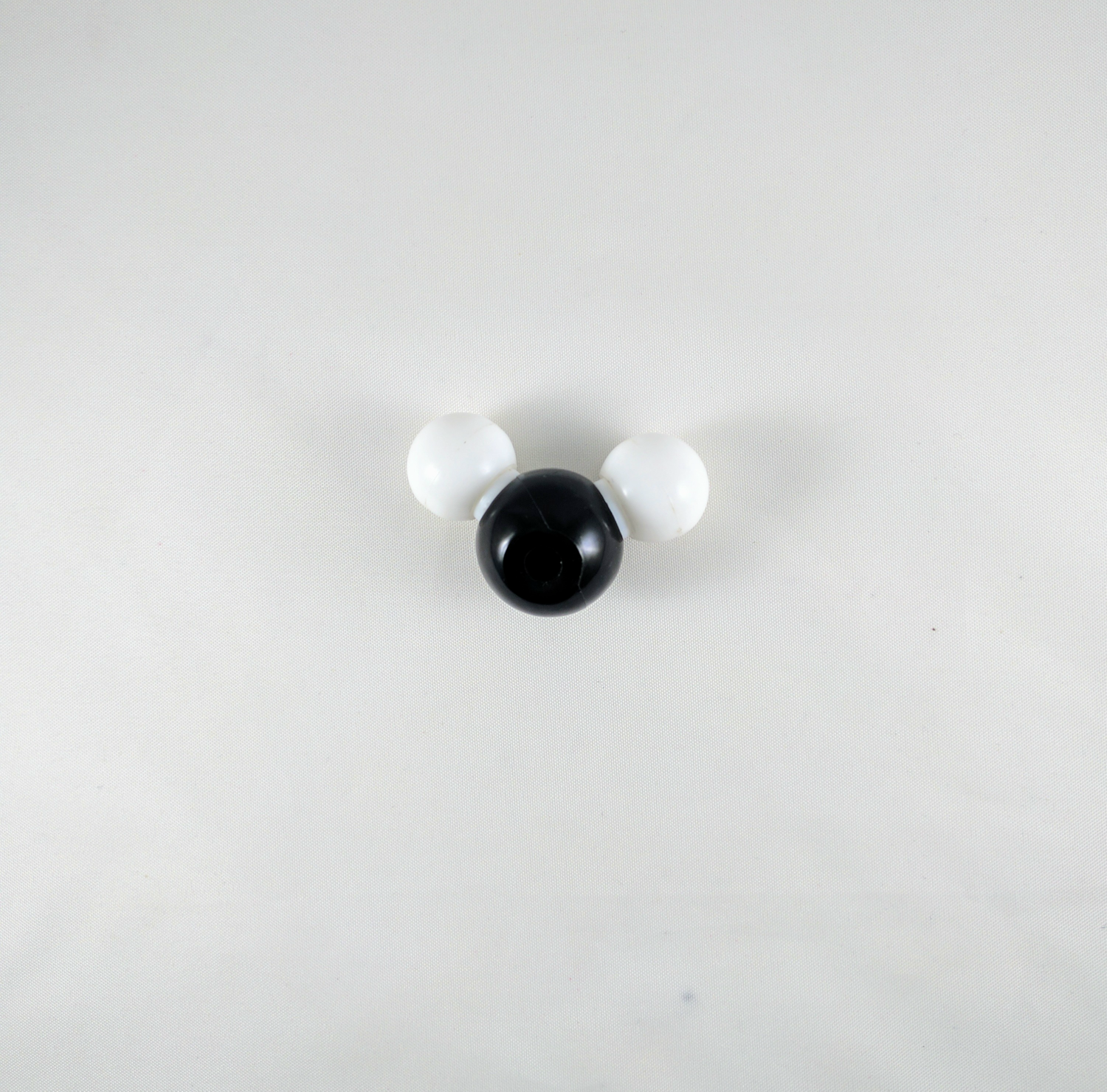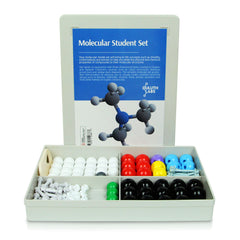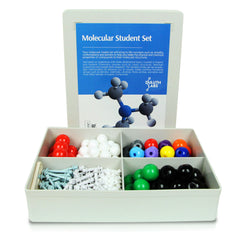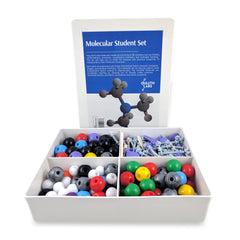Nicotine: This week’s molecule is Addictive!
Nicotine belongs to a large class of compounds called alkaloids. Alkaloids are nitrogenous compounds that occur naturally in most plants, and are best known for their medical uses. Nicotine is a naturally occurring compound found in tobacco, and is specifically known for its stimulant effects. When inhaled, nicotine reaches the brain so fast and elicits its effect on heart rate and blood pressure. It also acts on your nerves controlling your respiration, and changes your breathing patterns. High concentrations produce lethal effects – in fact, a single drop of it is enough to kill a person.
What does Nicotine look like in Chemistry?


Let’s Get Building!
Using your Student Molecular Model Set from Duluth Labs then let’s create Nicotine! You’ll need:
-
10 Carbon Atoms
-
2 Nitrogen Atom
-
14 Hydrogens
-
14 Small connectors (compact small bonds for hydrogen)
-
10 Medium connectors (single covalent bonds)
-
6 Long connectors
-
Molecular Tool (for Disassembly)
Put aside all the atoms and connectors needed.

Let’s start off with building our substituted pyridine ring. We will build this part of the molecule in a clockwise rotation, starting with the 12:00 position (Carbon 4). Kindly refer to the structure below.
Steps
-
1

1. First, get one carbon atom (Carbon 4), then attach one hydrogen atom above it using a small connector.
-
2

2. Then using 2 long connectors, attach another carbon atom (Carbon 3) to Carbon 4.
-
3

3. Attach another carbon atom (Carbon 2) below Carbon 3using 1 medium connector. Afterwards, add one hydrogen atom on Carbon 2 using a small connector.
-
4

4. Then, using 2 long connectors, attach a nitrogen atom (Nitrogen 1) on Carbon 2
-
5

5. Get another carbon atom (Carbon 6) then attach it to Nitrogen 1 using 1 medium connector and then add a hydrogen atom on Carbon 6 using a small connector.
-
6

6. Use 2 long connectors to attach another carbon (Carbon 5) above Carbon 6. Likewise, add a hydrogen atom on Carbon 5 using a small connector.
-
7

7. Join Carbons 5 and 4 together using a medium connector.
-

That’s it! We’ve just built out our Pyridine Structure.
Note: Looking at the structure closely, we can see that pyridine contains one nitrogen atom.
We will now proceed with building the pyrrolidine group of our Nicotine molecule. In this portion of our molecule, we start with Carbon 4’, then we will continue building it in a clockwise direction. Let’s continue!
-
1

1. First using a carbon atom (Carbon 4’) then attach 2 hydrogen atoms on it using 2 small connectors.
-
2

2. Using a medium connector, attach another carbon atom (Carbon 5’) below Carbon 4’. Afterwards, attach 2 hydrogen atoms on Carbon 5’ using 2 small connectors.
-
3

3. Then, get a nitrogen atom (Nitrogen 1’) and attach this to Carbon 5’ using a medium connector.
-
4

4. Then get a carbon atom and attach it below Nitrogen 1’ using a medium connector.
-
5

5. Place 3 hydrogen atoms on this carbon attached to Nitrogen 1’ using 3 small connectors.
Note: Joining 3 hydrogen atoms to 1 carbon atom will form a methyl group. This means, we just attached a methyl group on Nitrogen 1’ of our pyrrolidine molecule!
-
6

6. Get another carbon atom (Carbon 2’) then attach this to Nitrogen 1’ using a medium connector.
-
7

7. Using a small connector, attach a hydrogen atom on Carbon 2’. Twist Carbon 2’ in such a way that the hydrogen atom bonded to it faces towards you.
-
8

8. Then, using 1 medium connector, attach another carbon atom (Carbon 3’) on Carbon 2’. Afterwards attach 2 hydrogen atoms on Carbon 3’ using 2 small connectors.
-
9

9. Join Carbons 3’ and 4’ using a medium connector.
-
10

10. Now, this is the fun part: Using a medium connector, join Carbon 3(of the pyridine ring) and Carbon 2’ (of the pyrrolidine ring). As you join these 2, make sure that the rings appear “flat” on the floor, while keeping the hydrogen facing towards you.
There you have it! We’ve just built another molecule – Nicotine!
We hope to see how your nicotine molecule turned out!
Comment and share pictures below!
Tune in next week for another molecule of the week!
See you then xoxo :)
Afton Direct LLC
























https://www.yeezysofficialsite.com/ Yeezy
https://www.adidasuk.uk.com/ Adidas UK
https://www.jordan4.de/ Air Jordan 4
https://www.air-jordan1.us/ Air Jordan 1
https://www.air-jordan1.us/ Jordan 1
https://www.air-jordans.us/ Air Jordans
https://www.air-jordans.us/ Nike Air Jordans
https://www.jordans-1.us/ Jordans 1
https://www.jordans-1.us/ Air Jordan 1
https://www.nikejordan1.us/ Nike Jordan 1
https://www.nikejordan1.us/ Nike Jordan
https://www.jordan-1s.us/ Jordan 1s
https://www.jordan-1s.us/ Jordan 1
https://www.adidas-yeezy.org/ Adidas Yeezy
https://www.adidasyeezyofficialwebsite.com/ Adidas Yeezy
https://www.adidasyeezyofficialwebsite.com/ Yeezy
https://www.adidasyeezys.com/ Adidas Yeezy
https://www.adidasyeezys.org/ Adidas Yeezy
https://www.adidasyeezys.org/ Yeezy Shoes
https://www.air-jordan1.com/ Air Jordan 1
https://www.airjordan1s.us/ Air Jordan 1
https://www.airjordan1s.us/ Jordan 1
https://www.airjordan1s.us/ Jordan 1
https://www.air-jordan4.com/ Air Jordan 4
https://www.air-jordans.us.org/ Air Jordans
https://www.air-jordans1.com/ Air Jordan 1
https://www.air-jordans1.com/ Jordan 1
https://www.airjordan-shoes.us/ Air Jordan Shoes
https://www.airjordan-shoes.us/ Air Jordan
https://www.airsjordans.com/ Air Jordans
https://www.jordan-1.co.uk/ Air Jordan 1
https://www.jordan-1.co.uk/ Jordan 1
https://www.jordan-1.de/ Jordan 1
https://www.jordan-1.org/ Jordan 1
https://www.jordan1.uk.com/ Jordan 1
https://www.jordan-11s.com/ Jordan 11
https://www.jordan-1s.com/ Jordan 1s
https://www.jordan-4.co.uk/ Air Jordan 4
https://www.jordan-4.co.uk/ Jordan 4
https://www.jordan4.de/ Air Jordan 4
https://www.jordan4.de/ Jordan 4
https://www.jordan-4.us/ Air Jordan 4
https://www.jordan-4.us/ Jordan 4
https://www.jordan4militaryblack.us/ Jordan
https://www.jordan4militaryblack.us/ Jordan 4 Military Black
https://www.jordan-4s.us/ Jordan 4
https://www.jordan-4s.us/ Jordan 4s
https://www.jordanretro4.com/ Jordan Retro 4
https://www.jordans-11.com/ Jordan 11
https://www.jordans4s.com/ Jordans 4
https://www.jordan-shoes.us.com/ Jordan Shoes
https://www.jordans-shoes.com/ Jordans Shoes
https://www.nflshopofficialonlinestore.com/ NFL Shop Official Online Store
https://www.nikeair-jordan.com/ Nike Air Jordan
https://www.nikeairvapormax.us/ Nike Air VaporMax
https://www.nikejordan1.com/ Nike Jordan 1
https://www.nike-jordans.com/ Nike Jordans
https://www.nikeoutlet.uk.com/ Nike Outlet
https://www.nikeoutletshopping.com/ Nike Outlet Store
https://www.nikeoutletshopping.com/ Nike Outlet
https://www.nikeoutletshopping.us.com/ Nike Outlet Store Online Shopping
https://www.nikeoutletshopping.us.com/ Nike Outlet
https://www.nikes-shoes.com/ Nike Shoes
https://www.nikeuk.uk.com/ Nike UK
https://www.off-white.us.org/ Off White
https://www.yeezy.uk.com/ Yeezy
https://www.yeezy350.uk.com/ Yeezy 350
https://www.yeezy350.uk.com/ Yeezy
https://www.yeezy-350s.com/ Yeezy 350
https://www.yeezy-350s.com/ Yeezy Boost 350
https://www.yeezy350-v2.com/ Yeezy 350 V2
https://www.yeezy-450.com/ Yeezy 450
https://www.yeezy-700.us.com/ Yeezy 700
https://www.yeezyadidas.de/ Adidas yeezy
https://www.yeezyfoam-runner.com/ Yeezy Foam Runner
https://yeezys-350.com/ Yeezy
https://www.yeezy-shoes.us.com/ Yeezy
https://www.yeezys.uk.com/ Yeezy Shoes
https://www.yeezys.uk.com/ Yeezy
https://www.yeezyslides.us.com/ Yeezy Slides
https://www.yeezysslides.com/ Yeezy Slides
https://www.yeezys-supply.com/ Yeezy Supply
https://www.jordans-shoes.com/ Jordan Shoes
https://www.jordans-shoes.com/ Jordans
https://www.yeezy-slides.org/ Yeezy Slides
https://www.nike-shoess.us/ Nike Shoes
https://www.nikesale.us.com/ Nike Outlet
https://www.nike-outlets.org/ Nike Outlet
https://www.raybansglassesoutlet.us.com/ Ray-Ban Sunglasses
https://www.yeezyshoess.co/ Yeezy Shoes
https://www.moncjacket.com/ Moncler Jacket
https://www.moncler-outlet.net/ Moncler Outlet
https://www.moncler-outlets.org/ Moncler Outlet
https://www.monclerjacket.uk.com/ Moncler Jacket
https://www.monclers.uk.com/ Moncler
https://www.monclers.uk.com/ Moncler UK
https://www.monclerjacket.us.com/ Moncler Jacket
https://www.monclers.org/ Moncler
https://www.moncoutlet.us/ Moncler Outlet
https://www.yeezysale.us/ Yeezy
https://www.yeezyshoessneakers.us/ Yeezy Shoes
https://www.yeezysneakers.org/ Yeezy Sneakers
https://www.yeezywebsite.us/ Yeezy
https://www.yzyshoes.us.com/ Yeezy Shoes
https://www.yeezys350.org/ Yeezy 350
https://www.pandorajewelries.us/ Pandora Jewelry
https://www.pandora-s.us.com/ Pandora
https://www.yeezysale.us/ Yeezy
https://www.yeezyshoessneakers.us/ Yeezy Shoes
https://www.yeezysneakers.org/ Yeezy Sneakers
https://www.yeezywebsite.us/ Yeezy
https://www.yzyshoes.us.com/ Yeezy Shoes
https://www.yeezys350.org/ Yeezy 350
https://www.pandorajewelries.us/ Pandora Jewelry
https://www.pandora-s.us.com/ Pandora
https://www.pandora-s.us.com/ Pandora Jewelry
https://www.yeezy-s.us/ Yeezy
https://raybansales.us/ Ray Bans
https://raybansales.us/ Ray Bans Sunglasses
https://raybansales.us/ Ray Ban Outlet
https://pandorajewelries.us.com/ Pandora Jewelry
https://www.yeezys-slides.us.com/ Yeezy Slides
https://www.yeezyadidass.us.com/ Adidas Yeezy
https://www.shoesyeezys.us.com/ Yeezy Shoes
https://www.350yeezy.us.com/ Yeezy 350
https://www.yeezyy.us.com/ Yeezy
https://www.yeezy350s.us.com/ Yeezy 350
https://www.yeezyshoesboost.com/ Yeezy Shoes
https://sites.google.com/site/movinmakkah/ شركة نقل عفش بجدة
https://sites.google.com/site/movinmakkah/moversinmecca شركة نقل عفش بمكة
https://sites.google.com/site/movinmakkah/qassim-movers نقل عفش بالقصيم
https://sites.google.com/site/movinmakkah/moversinahsa نقل عفش بالاحساء
https://sites.google.com/site/movinmakkah/jeddah
https://sites.google.com/site/movinmakkah/madina
https://sites.google.com/site/movinmakkah/taif
https://sites.google.com/site/movinmakkah/furniture-storage-mecca
https://sites.google.com/site/movinmakkah/takhazaynintabuk
https://sites.google.com/site/movinmakkah/movers-in-khulais
https://sites.google.com/site/movinmakkah/movinginjeddah-samer
https://sites.google.com/site/movinmakkah/riyadh
https://sites.google.com/site/movinmakkah/slricom
https://sites.google.com/site/movinmakkah/mecca-movers
https://sites.google.com/site/moversintaif/ شركة نقل عفش بالطائف
https://sites.google.com/site/moversintaif/home نقل اثاث بالطائف
https://sites.google.com/site/moversintaif/makkah شركة نقل عفش بمكة
https://sites.google.com/site/moversintaif/dammam-movers نقل عفش بالدمام
https://sites.google.com/site/moversintaif/moversinriyadh نقل اثاث بالرياض
https://sites.google.com/site/moversintaif/afsh نقل عفش بالطايف
https://sites.google.com/site/moversintaif/khamismushait-movers
https://sites.google.com/site/moversintaif/jazan-movers نقل عفش بجازان
https://sites.google.com/site/moversintaif/movers-ahsa نقل عفش بالاحساء
https://sites.google.com/site/moversintaif/alkhobar نقل عفش بالخبر
https://sites.google.com/site/moversintaif/jubail نقل عفش بالجبيل
https://sites.google.com/site/moversintaif/yanbu نقل عفش ينبع
https://sites.google.com/site/moversintaif/moversinqassim نقل عفش بالمدينة
https://sites.google.com/site/moversintaif/furnituremovers-qassim
https://sites.google.com/site/moversintaif/abha نقل عفش بابها
https://sites.google.com/site/moversintaif/almadina
https://sites.google.com/site/moversintaif/tabuk
https://sites.google.com/site/moversintaif/rabigh
https://sites.google.com/site/moversintaif/najran
https://sites.google.com/site/moversintaif/movers-alkharj
https://sites.google.com/site/moversintaif/movers-elbaha
https://sites.google.com/site/moversintaif/moversintabuk
https://sites.google.com/site/moversintaif/Company-numbers
https://sites.google.com/site/moversintaif/cleaning-carpet-tabuk
https://sites.google.com/site/moversintaif/cleaningtabuk
https://sites.google.com/site/moversintaif/cleaninginmedina
https://sites.google.com/site/moversintaif/cleaningindammam
https://sites.google.com/site/moversintaif/cleaningindammam
https://sites.google.com/site/moversintaif/cleaning-jeddah
https://sites.google.com/site/moversintaif/clean-makkah
https://sites.google.com/site/moversintaif/cleaning
https://sites.google.com/site/moversintaif/buy-furniture-riyadh
https://sites.google.com/site/moversintaif/moversinjeddah-abhor
https://sites.google.com/site/moversintaif/transfer-furniture-jeddah
https://sites.google.com/site/moversintaif/furniture-movers-yanbu
https://sites.google.com/site/moversintaif/buraydah-movers
https://sites.google.com/site/moversintaif/hail-movers
https://sites.google.com/site/moversintaif/moversintabuk
https://sites.google.com/site/moversintaif/Company-numbers
https://sites.google.com/site/moversintaif/jeddah
https://sites.google.com/site/moversintaif/riyadh
https://sites.google.com/site/moversintaif/dammam
https://sites.google.com/site/afashdammam/
https://sites.google.com/site/afashdammam/toqassim
https://sites.google.com/site/afashdammam/transfer-furniture-riyadh
https://sites.google.com/site/afashdammam/takhazayn-aldamam
https://sites.google.com/site/afashdammam/al-hasa-cleaning
https://sites.google.com/site/afashdammam/alahsa
https://sites.google.com/site/afashdammam/movingfurniture-qatif
https://sites.google.com/site/afashdammam/movingfurniture-zahran
https://sites.google.com/site/movingfurnitureinmecca/
https://sites.google.com/site/movingfurnitureinmecca/cleaninginmecca
https://sites.google.com/site/movingfurnitureinmecca/gomoom-movers
https://sites.google.com/site/movinginmeccariyadh/
https://sites.google.com/site/movinginmeccariyadh/jeddah
https://sites.google.com/site/moversinnajran/
https://sites.google.com/site/moversinnajran/dammam
https://sites.google.com/site/moversinnajran/jubail
https://sites.google.com/site/moversinnajran/riyadh
https://sites.google.com/site/moversinnajran/transfere-riyadh
https://sites.google.com/site/moversalbaaha/
https://sites.google.com/site/moversalbaaha/taif
https://sites.google.com/site/moversalbaaha/dammam
https://sites.google.com/site/moversalbaaha/description
https://sites.google.com/site/moversalbaaha/taiftoelbaha
https://sites.google.com/site/transferjazanjeddah/
https://sites.google.com/site/transferjazanjeddah/riyadh
https://sites.google.com/site/transferjazanjeddah/dammam
https://sites.google.com/site/transferjazanjeddah/habitat
https://sites.google.com/site/movingfurnitureinmakkah/
https://sites.google.com/site/movingfurnitureinmakkah/yanbu
https://sites.google.com/site/movingfurnitureinmakkah/qassim
https://sites.google.com/site/transfertojeddah/
https://sites.google.com/site/transfertojeddah/khamismushait
https://sites.google.com/site/rabighalalameya/
https://sites.google.com/site/rabighalalameya/tabuk
https://sites.google.com/site/rabighalalameya/riyadh
https://sites.google.com/site/rabighalalameya/qassim
https://sites.google.com/site/rabighalalameya/dammam
https://sites.google.com/site/rabighalalameya/mecca
https://sites.google.com/site/rabighalalameya/jeddahtabuk
https://sites.google.com/site/rabighalalameya/cleaninginmedina
https://sites.google.com/site/transferfurnitureyanbu/
https://sites.google.com/site/transferfurnitureyanbu/riyadh
https://sites.google.com/site/transferfurnitureyanbu/almadina
https://sites.google.com/site/transferfurnitureyanbu/dammam
https://sites.google.com/site/riyadhjedah/
https://sites.google.com/site/movmakkah/
https://sites.google.com/site/naqelinmakkah/
https://groups.google.com/g/moversintaifmovers
https://groups.google.com/g/movingf-urniture-companies
https://cutt.ly/u2jE5Vl
카지노사이트 https://ce-top10.com/
바카라사이트 https://ce-top10.com/
온라인카지노 https://ce-top10.com/
온라인바카라 https://ce-top10.com/
온라인슬롯사이트 https://ce-top10.com/
카지노사이트게임 https://ce-top10.com/
카지노사이트검증 https://ce-top10.com/
카지노사이트추천 https://ce-top10.com/
안전카지노사이트 https://ce-top10.com/
안전카지노사이트도메인 https://ce-top10.com/
안전한 카지노사이트 추천 https://ce-top10.com/
바카라사이트게임 https://ce-top10.com/
바카라사이트검증 https://ce-top10.com/
바카라사이트추천 https://ce-top10.com/
안전바카라사이트 https://ce-top10.com/
안전바카라사이트도메인 https://ce-top10.com/
안전한 바카라사이트 추천 https://ce-top10.com/
http://toolbarqueries.google.com.uy/url?sa=t&url=https://ce-top10.com/
http://toolbarqueries.google.com.tw/url?sa=t&url=https://ce-top10.com/
http://toolbarqueries.google.com.tr/url?sa=t&url=https://ce-top10.com/
http://toolbarqueries.google.com.sa/url?sa=t&url=https://ce-top10.com/
http://toolbarqueries.google.com.py/url?sa=t&url=https://ce-top10.com/
http://toolbarqueries.google.com.pr/url?sa=t&url=https://ce-top10.com/
http://toolbarqueries.google.com.pk/url?sa=t&url=https://ce-top10.com/
http://toolbarqueries.google.com.pe/url?sa=t&url=https://ce-top10.com/
http://toolbarqueries.google.com.my/url?sa=t&url=https://ce-top10.com/
http://toolbarqueries.google.com.hk/url?sa=t&url=https://ce-top10.com/
http://toolbarqueries.google.com.gt/url?sa=t&url=https://ce-top10.com/
http://toolbarqueries.google.com.gh/url?sa=t&url=https://ce-top10.com/
https://clients1.google.com.ar/url?sa=t&url=https://ce-top10.com/
https://clients1.google.com.ag/url?sa=t&url=https://ce-top10.com/
https://clients1.google.co.zm/url?sa=t&url=https://ce-top10.com/
https://clients1.google.co.za/url?sa=t&url=https://ce-top10.com/
https://clients1.google.co.ve/url?sa=t&url=https://ce-top10.com/
https://clients1.google.co.uz/url?sa=t&url=https://ce-top10.com/
https://clients1.google.co.ug/url?sa=t&url=https://ce-top10.com/
https://clients1.google.co.th/url?sa=t&url=https://ce-top10.com/
https://clients1.google.co.nz/url?sa=t&url=https://ce-top10.com/
https://clients1.google.co.kr/url?sa=t&url=https://ce-top10.com/
https://clients1.google.co.ke/url?sa=t&url=https://ce-top10.com/
https://clients1.google.co.il/url?sa=t&url=https://ce-top10.com/
https://clients1.google.co.id/url?sa=t&url=https://ce-top10.com/
https://clients1.google.co.cr/url?sa=t&url=https://ce-top10.com/
https://clients1.google.co.ck/url?sa=t&url=https://ce-top10.com/
https://cse.google.co.ck/url?sa=t&url=https://ce-top10.com/
https://cse.google.co.bw/url?sa=t&url=https://ce-top10.com/
https://cse.google.cm/url?sa=t&url=https://ce-top10.com/
https://cse.google.cl/url?sa=t&url=https://ce-top10.com/
https://cse.google.ci/url?sa=t&url=https://ce-top10.com/
https://cse.google.ch/url?sa=t&url=https://ce-top10.com/
https://cse.google.ch/url?sa=i&url=https://ce-top10.com/
https://cse.google.cg/url?sa=t&url=https://ce-top10.com/
https://cse.google.cd/url?sa=t&url=https://ce-top10.com/
https://cse.google.by/url?sa=t&url=https://ce-top10.com/
https://cse.google.bs/url?sa=t&url=https://ce-top10.com/
https://cse.google.bi/url?sa=t&url=https://ce-top10.com/
https://cse.google.bg/url?sa=t&url=https://ce-top10.com/
https://cse.google.be/url?sa=t&url=https://ce-top10.com/
https://cse.google.be/url?sa=i&url=https://ce-top10.com/
https://cse.google.ba/url?sa=t&url=https://ce-top10.com/
https://cse.google.az/url?sa=t&url=https://ce-top10.com/
https://cse.google.at/url?sa=t&url=https://ce-top10.com/
https://images.google.ca/url?sa=t&url=https://usgambling15465.blogspot.com/2023/03/all-in-poker.html
https://images.google.by/url?sa=t&url=https://usgambling15465.blogspot.com/2023/03/all-in-poker.html
https://images.google.bs/url?sa=t&url=https://usgambling15465.blogspot.com/2023/03/all-in-poker.html
https://images.google.bi/url?sa=t&url=https://usgambling15465.blogspot.com/2023/03/all-in-poker.html
https://images.google.bg/url?sa=t&url=https://usgambling15465.blogspot.com/2023/03/all-in-poker.html
https://images.google.bf/url?sa=t&url=https://usgambling15465.blogspot.com/2023/03/all-in-poker.html
https://images.google.be/url?sa=t&url=https://usgambling15465.blogspot.com/2023/03/all-in-poker.html
https://images.google.ba/url?sa=t&url=https://usgambling15465.blogspot.com/2023/03/all-in-poker.html
https://images.google.ba/url?q=https://usgambling15465.blogspot.com/2023/03/all-in-poker.html
https://images.google.az/url?sa=t&url=https://usgambling15465.blogspot.com/2023/03/all-in-poker.html
https://images.google.at/url?sa=t&url=https://usgambling15465.blogspot.com/2023/03/all-in-poker.html
https://images.google.as/url?sa=t&url=https://usgambling15465.blogspot.com/2023/03/all-in-poker.html
https://images.google.am/url?sa=t&url=https://usgambling15465.blogspot.com/2023/03/all-in-poker.html
https://images.google.al/url?sa=t&url=https://usgambling15465.blogspot.com/2023/03/all-in-poker.html
https://images.google.ae/url?sa=t&url=https://usgambling15465.blogspot.com/2023/03/all-in-poker.html
https://images.google.ae/url?q=https://usgambling15465.blogspot.com/2023/03/all-in-poker.html
https://images.google.ad/url?sa=t&url=https://usgambling15465.blogspot.com/2023/03/all-in-poker.html
https://maps.google.co.ke/url?sa=t&url=https://usgambling15465.blogspot.com/2023/03/all-in-poker.html
https://maps.google.co.jp/url?sa=t&url=https://usgambling15465.blogspot.com/2023/03/all-in-poker.html
https://maps.google.co.in/url?sa=t&url=https://usgambling15465.blogspot.com/2023/03/all-in-poker.html
https://maps.google.co.il/url?sa=t&url=https://usgambling15465.blogspot.com/2023/03/all-in-poker.html
https://maps.google.co.id/url?sa=t&url=https://usgambling15465.blogspot.com/2023/03/all-in-poker.html
https://maps.google.co.cr/url?sa=t&url=https://usgambling15465.blogspot.com/2023/03/all-in-poker.html
https://maps.google.co.bw/url?sa=t&url=https://usgambling15465.blogspot.com/2023/03/all-in-poker.html
https://maps.google.cm/url?sa=t&url=https://usgambling15465.blogspot.com/2023/03/all-in-poker.html
https://maps.google.cl/url?sa=t&url=https://usgambling15465.blogspot.com/2023/03/all-in-poker.html
https://maps.google.ci/url?sa=t&url=https://usgambling15465.blogspot.com/2023/03/all-in-poker.html
https://maps.google.ch/url?sa=t&url=https://usgambling15465.blogspot.com/2023/03/all-in-poker.html
https://maps.google.cd/url?sa=t&url=https://usgambling15465.blogspot.com/2023/03/all-in-poker.html
https://maps.google.cat/url?sa=t&url=https://usgambling15465.blogspot.com/2023/03/all-in-poker.html
https://maps.google.ca/url?sa=t&url=https://usgambling15465.blogspot.com/2023/03/all-in-poker.html
https://www.google.co.tz/url?sa=t&url=https://usgambling15465.blogspot.com/2023/03/all-in-poker.html
https://www.google.co.th/url?sa=t&url=https://usgambling15465.blogspot.com/2023/03/all-in-poker.html
https://www.google.co.nz/url?sa=t&url=https://usgambling15465.blogspot.com/2023/03/all-in-poker.html
https://www.google.co.ma/url?sa=t&url=https://usgambling15465.blogspot.com/2023/03/all-in-poker.html
https://www.google.co.ls/url?sa=t&url=https://usgambling15465.blogspot.com/2023/03/all-in-poker.html
https://www.google.co.kr/url?sa=t&url=https://usgambling15465.blogspot.com/2023/03/all-in-poker.html
https://www.google.co.ke/url?sa=t&url=https://usgambling15465.blogspot.com/2023/03/all-in-poker.html
https://www.google.co.jp/url?sa=t&url=https://usgambling15465.blogspot.com/2023/03/all-in-poker.html
https://www.google.co.in/url?sa=t&url=https://usgambling15465.blogspot.com/2023/03/all-in-poker.html
https://www.google.co.il/url?sa=t&url=https://usgambling15465.blogspot.com/2023/03/all-in-poker.html
https://www.google.co.id/url?sa=t&url=https://usgambling15465.blogspot.com/2023/03/all-in-poker.html
https://www.google.co.cr/url?sa=t&url=https://usgambling15465.blogspot.com/2023/03/all-in-poker.html
https://www.google.co.bw/url?sa=t&url=https://usgambling15465.blogspot.com/2023/03/all-in-poker.html
https://www.google.cm/url?sa=t&url=https://usgambling15465.blogspot.com/2023/03/all-in-poker.html
https://www.google.cl/url?sa=t&url=https://usgambling15465.blogspot.com/2023/03/all-in-poker.html
https://www.google.ci/url?sa=t&url=https://usgambling15465.blogspot.com/2023/03/all-in-poker.html
https://www.google.ch/url?sa=t&url=https://usgambling15465.blogspot.com/2023/03/all-in-poker.html
https://www.google.cd/url?sa=t&url=https://usgambling15465.blogspot.com/2023/03/all-in-poker.html
https://www.google.cat/url?sa=t&url=https://usgambling15465.blogspot.com/2023/03/all-in-poker.html
https://www.google.ca/url?sa=t&url=https://usgambling15465.blogspot.com/2023/03/all-in-poker.html
안전 온라인카지노_https://betop24.com/
온라인 카지노 먹튀검증_https://betop24.com/
안전 카지노사이트_https://betop24.com/
온라인카지노 추천_https://betop24.com/
바카라사이트 추천_https://betop24.com/
파라오카지노_https://betop24.com/pharaoh-casino/
쿨카지노_https://betop24.com/cool-casino/
뉴헤븐카지노_https://betop24.com/nhcasino/
솔카지노_https://betop24.com/solcasino/
펀카지노_https://betop24.com/fun-casino/
헤라카지노_https://betop24.com/hera-casino/
J9카지노_https://betop24.com/j9-casino/
https://sites.google.com/view/betop24link/%EC%95%88%EC%A0%84-%EC%B9%B4%EC%A7%80%EB%85%B8%EC%82%AC%EC%9D%B4%ED%8A%B8/betop24
https://paste.myst.rs/ygke48wm
https://paste.enginehub.org/IDSg9YSy_
https://paste2.org/O4WGyeFB
https://pasteio.com/xRU9Rbj21TZd
https://bitbin.it/S8vGoFA1/
https://yamcode.com/betop24-81
https://pastelink.net/1zwgj9p6
https://ivpaste.com/v/KjG2buBzcR
https://commie.io/#44qG7gGa
https://rentry.co/3reuk
http://nopaste.ceske-hry.cz/399360
https://pastelink.net/672gktrr
https://linktr.ee/betop24
https://taplink.cc/betop24
https://sleek.bio/betop24
https://betop24.carrd.co/
https://linkbio.co/5021212kwSXqz
https://solo.to/betop24
https://biolinky.co/betop24
https://linkfly.to/50212Y9UCdO
https://controlc.com/89681ef4
https://bitbin.it/dKmAygCF/
https://yamcode.com/untitled-62448
https://notes.io/q4g25
https://pastebin.com/Yqg2czD1
https://pastelink.net/3w9btm1u
https://paste.feed-the-beast.com/view/6fc3c45a
https://pasteio.com/xO4kpVtkWQ8W
https://justpaste.it/betop24
https://pastebin.freeswitch.org/view/4fc5b866
http://pastebin.falz.net/2499691
https://paste.laravel.io/33eed31e-0510-432f-b265-77715da89b55
https://paste2.org/ZVwLzFHb
https://paste.myst.rs/80wsv443
https://controlc.com/89681ef4
https://bitbin.it/dKmAygCF/
https://pastehere.xyz/oJXlublq7/
https://rentry.co/aqcmh
https://paste.enginehub.org/cBOWjUldx
http://nopaste.paefchen.net/1939933
https://anotepad.com/note/read/y22eawf8
https://ivpaste.com/v/ylPwpbLVGA
http://nopaste.ceske-hry.cz/399193
https://commie.io/#5Vv0rqZx
http://paste.jp/2b1e81a5/
https://fdeam.finanzen-partnerprogramm.de/tracking/?as_id=9257&c_id=595&url=https://betop24.com/
https://pdcn.co/e/https://betop24.com/
https://api.webconnex.com/v1/postmaster/track/click/4f8036d14ee545798599c8921fbfcd22/db005310dba511e89fb606f49a4ee876?url=https://betop24.com/
https://www.lecake.com/stat/goto.php?url=https://betop24.com/
https://www.im-harz.com/counter/counter.php?url=https://betop24.com/
https://pzz.to/click?uid=8571&target_url=https://betop24.com/
https://www.ricacorp.com/Ricapih09/redirect.aspx?link=https://betop24.com/
https://www.tremblant.ca/Shared/LanguageSwitcher/ChangeCulture?culture=en&url=https://betop24.com/
https://www.winxuan.com/page/cps/eqifacookieinterface.jsp?from=yiqifa&wid=8&url=https://betop24.com/
https://moscowdesignmuseum.ru/bitrix/rk.php?goto=https://betop24.com/
https://igert2011.videohall.com/to_client?target=https://betop24.com/
http://micimpact.com/bannerhit.php?bn_id=31&url=https://betop24.com/
https://ovatu.com/e/c?url=https://betop24.com/
https://primepartners.globalprime.com/afs/wcome.php?c=427|0|1&e=GP204519&url=https://betop24.com/
https://ltp.org/home/setlocale?locale=en&returnUrl=https://betop24.com/
https://www.morhipo.com/shared/partnercookie?k=gort&url=https://betop24.com/
https://cingjing.fun-taiwan.com/AdRedirector.aspx?padid=303&target=https://betop24.com/
https://rtb-asiamax.tenmax.io/bid/click/1462922913409/e95f2c30-1706-11e6-a9b4-a9f6fe33c6df/3456/5332/?rUrl=https://betop24.com/
https://needsfs.clientcommunity.com.au/?EXT_URL=https://betop24.com/&MID=92738
https://campaign.unitwise.com/click?emid=31452&emsid=ee720b9f-a315-47ce-9552-fd5ee4c1c5fa&url=https://betop24.com/
https://www.stuhleck.com/io/out.asp?url=https://betop24.com/
https://www.swipeclock.com/sc/cookie.asp?sitealias=79419397&redirect=https://betop24.com/
https://www.gutscheinaffe.de/wp-content/plugins/AND-AntiBounce/redirector.php?url=https://betop24.com/
https://home.uceusa.com/Redirect.aspx?r=https://betop24.com/
https://www.prodesigns.com/redirect?url=https://betop24.com/
https://www.seankenney.com/include/jump.php?num=https://betop24.com/
https://runningcheese.com/go?url=https://betop24.com/
http://chtbl.com/track/118167/https://betop24.com/
https://ads.glassonline.com/ads.php?id_banner=370&id_campaign=291&link=https://betop24.com/
https://m.17ll.com/apply/tourl/?url=https://betop24.com/
https://crewroom.alpa.org/SAFETY/LinkClick.aspx?link=https://betop24.com/&mid=12872
https://www.sponsorship.com/Marketplace/redir.axd?ciid=514&cachename=advertising&PageGroupId=14&url=https://betop24.com/
https://rs.businesscommunity.it/snap.php?u=https://betop24.com/
http://dstats.net/redir.php?url=https://betop24.com/
https://www.aiac.world/pdf/October-December2015Issue?pdf_url=https://betop24.com/
https://click.alamode.com/?adcode=CPEMAQM0913_1&url=https://betop24.com/%20
https://m.caijing.com.cn/member/logout?referer=https://betop24.com/
https://jamesattorney.agilecrm.com/click?u=https://betop24.com/
https://wikimapia.org/external_link?url=https://betop24.com/
https://www.expoon.com/link?url=https://betop24.com/
https://rsv.nta.co.jp/affiliate/set/af100101.aspx?site_id=66108024&redi_url=https://betop24.com/
https://adengine.old.rt.ru/go.jsp?to=https://betop24.com/
https://thediplomat.com/ads/books/ad.php?i=4&r=https://betop24.com/
https://mitsui-shopping-park.com/lalaport/iwata/redirect.html?url=https://betop24.com/
https://m.addthis.com/live/redirect/?url=https://betop24.com/
https://za.zalo.me/v3/verifyv2/pc?token=OcNsmjfpL0XY2F3BtHzNRs4A-hhQ5q5sPXtbk3O&continue=https://betop24.com/%20
https://scanmail.trustwave.com/?c=8510&d=4qa02KqxZJadHuhFUvy7ZCUfI_2L10yeH0EeBz7FGQ&u=https://betop24.com/
https://animal.doctorsfile.jp/redirect/?ct=doctor&id=178583&url=https://betop24.com/
https://hr.pecom.ru/bitrix/rk.php?goto=https://betop24.com/
https://jump2.bdimg.com/mo/q/checkurl?url=https://betop24.com/
https://severeweather.wmo.int/cgi-bin/goto?where=https://betop24.com/
https://beam.jpn.org/rank.cgi?mode=link&url=https://betop24.com/
https://jump2.bdimg.com/mo/q/checkurl?url=https://betop24.com/
https://gar86.tmweb.ru/bitrix/rk.php?goto=https://betop24.com/
https://blogranking.fc2.com/out.php?id=414788&url=https://betop24.com
https://wtk.db.com/777554543598768/optout?redirect=https://betop24.com/
https://community.rsa.com/t5/custom/page/page-id/ExternalRedirect?url=https%3A%2F%2Fbetop24.com
https://click.alamode.com/?adcode=CPEMAQM0913_1&url=https://betop24.com/
http://teenstgp.us/cgi-bin/out.cgi?u=https://betop24.com/
http://congovibes.com/index.php?thememode=full;redirect=https://betop24.com/
http://www.humaniplex.com/jscs.html?hj=y&ru=https://betop24.com/
http://www.qlt-online.de/cgi-bin/click/clicknlog.pl?link=https://betop24.com/
http://ww.sdam-snimu.ru/redirect.php?url=https://betop24.com/
http://www.uktrademarkregistration.co.uk/JumpTo.aspx?url=https://betop24.com/
http://landbidz.com/redirect.asp?url=https://betop24.com/
http://www.macro.ua/out.php?link=https://betop24.com/
http://www.aurki.com/jarioa/redirect?id_feed=510&url=https://betop24.com/
http://m.ee17.com/go.php?url=https://betop24.com/
http://shop-navi.com/link.php?mode=link&id=192&url=https://betop24.com/
http://www.cnainterpreta.it/redirect.asp?url=https://betop24.com/
http://www.site-navi.net/sponavi/rank.cgi?mode=link&id=890&url=https://betop24.com/
https://www.mattias.nu/cgi-bin/redirect.cgi?https://betop24.com/
http://distributors.hrsprings.com/?URL=betop24.com
http://dorf-v8.de/url?q=https://betop24.com/
http://doverwx.com/template/pages/station/redirect.php?url=https://betop24.com/
http://dr-guitar.de/quit.php?url=https://betop24.com/
http://drdrum.biz/quit.php?url=https://betop24.com/
http://ds-media.info/url?q=https://betop24.com/
http://excitingperformances.com/?URL=betop24.com
http://familie-huettler.de/link.php?link=betop24.com
http://forum.vizslancs.hu/lnks.php?uid=net&url=https://betop24.com/
http://forum.wonaruto.com/redirection.php?redirection=https://betop24.com/
http://fosteringsuccessmichigan.com/?URL=betop24.com
http://fotos24.org/url?q=https://betop24.com/
http://fouillez-tout.com/cgi-bin/redirurl.cgi?betop24.com
http://frag-den-doc.de/index.php?s=verlassen&url=https://betop24.com/
http://freethailand.com/goto.php?url=https://betop24.com/
http://freshcannedfrozen.ca/?URL=betop24.com
http://funkhouse.de/url?q=https://betop24.com/
http://ga.naaar.nl/link/?url=https://betop24.com/
http://gb.poetzelsberger.org/show.php?c453c4=betop24.com
http://gdnswebapppro.cloudapp.net/gooutside?url=https://betop24.com/
http://getmethecd.com/?URL=betop24.com
http://go.netatlantic.com/subscribe/subscribe.tml?list=michaelmoore&confirm=none&url=https://betop24.com/&email=hmabykq%40outlook.com
http://goldankauf-oberberg.de/out.php?link=https://betop24.com/
https://www.fairsandfestivals.net/?URL=https://betop24.com/
http://crewe.de/url?q=https://betop24.com/
http://cwa4100.org/uebimiau/redir.php?https://betop24.com/
http://d-quintet.com/i/index.cgi?id=1&mode=redirect&no=494&ref_eid=33&url=https://betop24.com/
http://data.allie.dbcls.jp/fct/rdfdesc/usage.vsp?g=https://betop24.com/
http://data.linkedevents.org/describe/?url=https://betop24.com/
http://datos.infolobby.cl/describe/?url=https://betop24.com/
http://congressrb.info/bitrix/rk.php?goto=https://betop24.com/
http://conny-grote.de/url?q=https://betop24.com/
http://crazyfrag91.free.fr/?URL=https://betop24.com
http://dayviews.com/externalLinkRedirect.php?url=https://betop24.com/
http://db.cbservices.org/cbs.nsf/forward?openform&https://betop24.com/
http://chatx2.whocares.jp/redir.jsp?u=https://betop24.com/
http://chuanroi.com/Ajax/dl.aspx?u=https://betop24.com/
http://club.dcrjs.com/link.php?url=https://betop24.com/
http://www.paladiny.ru/go.php?url=https://betop24.com/
http://tido.al/vazhdo.php?url=https://betop24.com/
http://smile.wjp.am/link-free/link3.cgi?mode=cnt&no=8&hpurl=https://betop24.com/
https://www.usjournal.com/go.php?campusID=190&url=https://betop24.com/
https://analytics.bluekai.com/site/16231?phint=event=click&phint=campaign=BRAND-TAB&phint=platform=search&done=https://betop24.com/
https://temptationsaga.com/buy.php?url=https://betop24.com/
https://www.cheerunion.org/tracker/index.html?t=ad&pool_id=2&ad_id=5&url=https://betop24.com/
https://www.moneydj.com/ads/adredir.aspx?bannerid=39863&url=https://betop24.com/
https://uk.kindofbook.com/redirect.php/?red=https://betop24.com/
http://m.17ll.com/apply/tourl/?url=https://betop24.com/
https://track.effiliation.com/servlet/effi.redir?id_compteur=13215059&url=https://betop24.com/
https://www.shtrih-m.ru/bitrix/redirect.php?goto=https://betop24.com/
http://simvol-veri.ru/xp/?goto=https://betop24.com/
http://www.skladcom.ru/(S(qdiwhk55jkcyok45u4ti0a55))/banners.aspx?url=https://betop24.com/
https://stroim100.ru/redirect?url=https://betop24.com/
https://kakaku-navi.net/items/detail.php?url=https://betop24.com/
https://meguro.keizai.biz/banner.php?type=image_banner&position=right&id=13&uri=https://betop24.com/
http://ads.cars.cz/adclick.php?bannerid=333&zoneid=237&source=&dest=https://betop24.com/
https://spb-medcom.ru/redirect.php?https://betop24.com/
https://www.info-realty.ru/bitrix/rk.php?goto=https://betop24.com/
http://www.sermemole.com/public/serbook/redirect.php?url=https://betop24.com/
https://www.hradycz.cz/redir.php?b=445&t=https://betop24.com/
http://prasat.blog.idnes.cz/redir.aspx?url=https://betop24.com/
http://meri.blog.idnes.cz/redir.aspx?url=https://betop24.com/
http://prabu.blog.idnes.cz/redir.aspx?url=https://betop24.com/
http://easehipranaam.blog.idnes.cz/redir.aspx?url=https://betop24.com/
http://nidatyi.blog.idnes.cz/redir.aspx?url=https://betop24.com/
http://krodyit.blog.idnes.cz/redir.aspx?url=https://betop24.com/
http://naine.blog.idnes.cz/redir.aspx?url=https://betop24.com/
http://breajwasi.blog.idnes.cz/redir.aspx?url=https://betop24.com/
http://beithe.blog.idnes.cz/redir.aspx?url=https://betop24.com/
http://tumari.blog.idnes.cz/redir.aspx?url=https://betop24.com/
http://hariomm.blog.idnes.cz/redir.aspx?url=https://betop24.com/
http://lejano.blog.idnes.cz/redir.aspx?url=https://betop24.com/
http://jotumko.blog.idnes.cz/redir.aspx?url=https://betop24.com/
http://auyttrv.blog.idnes.cz/redir.aspx?url=https://betop24.com/
http://bartos.blog.idnes.cz/redir.aspx?url=https://betop24.com/
http://cllfather.blog.idnes.cz/redir.aspx?url=https://betop24.com/
http://littlejohnny.blog.idnes.cz/redir.aspx?url=https://betop24.com/
http://semesmemos.blog.idnes.cz/redir.aspx?url=https://betop24.com/
http://faultypirations.blog.idnes.cz/redir.aspx?url=https://betop24.com/
http://mmurugesamnfo.blog.idnes.cz/redir.aspx?url=https://betop24.com/
http://esujkamien.blog.idnes.cz/redir.aspx?url=https://betop24.com/
http://ujkaeltnx.blog.idnes.cz/redir.aspx?url=https://betop24.com/
http://ausnangck2809.blog.idnes.cz/redir.aspx?url=https://betop24.com/
http://supermu.blog.idnes.cz/redir.aspx?url=https://betop24.com/
http://buyfcyclingteam.blog.idnes.cz/redir.aspx?url=https://betop24.com/
http://allthingnbeyondblog.blog.idnes.cz/redir.aspx?url=https://betop24.com/
http://usafunworldt.blog.idnes.cz/redir.aspx?url=https://betop24.com/
http://financialallorner.blog.idnes.cz/redir.aspx?url=https://betop24.com/
http://mjghouthernmatron.blog.idnes.cz/redir.aspx?url=https://betop24.com/
http://katihfmaxtron.blog.idnes.cz/redir.aspx?url=https://betop24.com/
http://ikkemandar.blog.idnes.cz/redir.aspx?url=https://betop24.com/
http://googlejfgdlenewstoday.blog.idnes.cz/redir.aspx?url=https://betop24.com/
http://bhrecadominicana.blog.idnes.cz/redir.aspx?url=https://betop24.com/
http://anupam-bestprice89.blog.idnes.cz/redir.aspx?url=https://betop24.com/
http://bhrepublica.blog.idnes.cz/redir.aspx?url=https://betop24.com/
http://allinspirations.blog.idnes.cz/redir.aspx?url=https://betop24.com/
http://bestandroid.blog.idnes.cz/redir.aspx?url=https://betop24.com/
http://discoverable.blog.idnes.cz/redir.aspx?url=https://betop24.com/
http://puriagatratt.blog.idnes.cz/redir.aspx?url=https://betop24.com/
http://azizlemon.blog.idnes.cz/redir.aspx?url=https://betop24.com/
http://chandancomputers.blog.idnes.cz/redir.aspx?url=https://betop24.com/
http://bingshopping.blog.idnes.cz/redir.aspx?url=https://betop24.com/
http://ptritam.blog.idnes.cz/redir.aspx?url=https://betop24.com/
http://tech-universes.blog.idnes.cz/redir.aspx?url=https://betop24.com/
http://littleboy.blog.idnes.cz/redir.aspx?url=https://betop24.com/
http://correctinspiration.blog.idnes.cz/redir.aspx?url=https://betop24.com/
http://weallfreieds.blog.idnes.cz/redir.aspx?url=https://betop24.com/
http://shanmegurad.blog.idnes.cz/redir.aspx?url=https://betop24.com/
http://manualmfuctional.blog.idnes.cz/redir.aspx?url=https://betop24.com/
http://verybeayurifull.blog.idnes.cz/redir.aspx?url=https://betop24.com/
http://dilip.blog.idnes.cz/redir.aspx?url=https://betop24.com/
http://avinasg.blog.idnes.cz/redir.aspx?url=https://betop24.com/
http://virat.blog.idnes.cz/redir.aspx?url=https://betop24.com/
http://hsadyttk.blog.idnes.cz/redir.aspx?url=https://betop24.com/
http://ashu-quality.blog.idnes.cz/redir.aspx?url=https://betop24.com/
http://tinko.blog.idnes.cz/redir.aspx?url=https://betop24.com/
http://konkaruna.blog.idnes.cz/redir.aspx?url=https://betop24.com/
http://udavhav.blog.idnes.cz/redir.aspx?url=https://betop24.com/
http://matura.blog.idnes.cz/redir.aspx?url=https://betop24.com/
http://kripa.blog.idnes.cz/redir.aspx?url=https://betop24.com/
http://charanraj.blog.idnes.cz/redir.aspx?url=https://betop24.com/
http://pream.blog.idnes.cz/redir.aspx?url=https://betop24.com/
http://sang.blog.idnes.cz/redir.aspx?url=https://betop24.com/
http://pasas.blog.idnes.cz/redir.aspx?url=https://betop24.com/
http://kanchan.blog.idnes.cz/redir.aspx?url=https://betop24.com/
http://ptrfsiitan.blog.idnes.cz/redir.aspx?url=https://betop24.com/
http://boardgame-breking.blog.idnes.cz/redir.aspx?url=https://betop24.com/
http://flowwergulab.blog.idnes.cz/redir.aspx?url=https://betop24.com/
http://bingcreater-uk.blog.idnes.cz/redir.aspx?url=https://betop24.com/
http://skinnyskin.blog.idnes.cz/redir.aspx?url=https://betop24.com/
http://amil.blog.idnes.cz/redir.aspx?url=https://betop24.com/
http://mohan.blog.idnes.cz/redir.aspx?url=https://betop24.com/
http://patana.blog.idnes.cz/redir.aspx?url=https://betop24.com/
http://bopal.blog.idnes.cz/redir.aspx?url=https://betop24.com/
http://gwl.blog.idnes.cz/redir.aspx?url=https://betop24.com/
http://delhi.blog.idnes.cz/redir.aspx?url=https://betop24.com/
http://gopi.blog.idnes.cz/redir.aspx?url=https://betop24.com/
http://boogiewoogie.com/?URL=betop24.com
http://bsumzug.de/url?q=https://betop24.com/
http://business.eatonton.com/list?globaltemplate=https://betop24.com/
http://cdiabetes.com/redirects/offer.php?URL=https://betop24.com/
https://padletcdn.com/cgi/fetch?disposition=attachment&url=https://betop24.com/
http://cdn.iframe.ly/api/iframe?url=https://betop24.com/
http://centuryofaction.org/?URL=betop24.com
http://alexanderroth.de/url?q=https://betop24.com/
http://alt.baunetzwissen.de/rd/nl-track/?obj=bnw&cg1=redirect&cg2=wissen-newsletter:beton&cg3=partner&datum=2017-01&titel=partnerklick-beton&firma=informationszentrumbeton&link=https://betop24.com/
http://andreasgraef.de/url?q=https://betop24.com/
http://app.espace.cool/ClientApi/SubscribeToCalendar/1039?url=https://betop24.com/
http://archive.paulrucker.com/?URL=https://betop24.com/
http://archives.midweek.com/?URL=betop24.com
http://bernhardbabel.com/url?q=https://betop24.com/
http://bigbarganz.com/g/?https://betop24.com/
http://bioinformatics.cenicafe.org/?URL=betop24.com
http://Somewh.a.T.dfqw@www.newsdiffs.org/article-history/www.findabeautyschool.com/map.aspx?url=https://betop24.com/
http://a-jansen.de/url?q=https://betop24.com/
http://actontv.org/?URL=betop24.com
http://ajman.dubaicityguide.com/main/advertise.asp?oldurl=https://betop24.com/
http://albertaaerialapplicators.com/?URL=betop24.com
http://blackberryvietnam.net/proxy.php?link=https://betop24.com/
http://baseballpodcasts.net/Feed2JS/feed2js.php?src=https://betop24.com/
http://bbs.mottoki.com/index?bbs=hpsenden&act=link&page=94&linkk=https://betop24.com/
http://armdrag.com/mb/get.php?url=https://betop24.com/
http://asai-kota.com/acc/acc.cgi?REDIRECT=https://betop24.com/
http://ass-media.de/wbb2/redir.php?url=https://betop24.com/
http://assadaaka.nl/?URL=betop24.com
http://atchs.jp/jump?u=https://betop24.com/
http://away3d.com/?URL=betop24.com
http://community.nxp.com/t5/custom/page/page-id/ExternalRedirect?url=https://betop24.com/
http://mitsui-shopping-park.com/lalaport/ebina/redirect.html?url=https://betop24.com/
http://kupiauto.zr.ru/bitrix/rk.php?goto=https://betop24.com/
http://ipx.bcove.me/?url=https://betop24.com/
http://client.paltalk.com/client/webapp/client/External.wmt?url=https://betop24.com/
http://www.interempresas.net/estadisticas/r.asp?idsector=129&e=221083&c=195&d=https://betop24.com/
http://fishbiz.seagrant.uaf.edu/click-thru.html?url=https://betop24.com/
http://foro.infojardin.com/proxy.php?link=https://betop24.com/
http://www.t.me/iv?url=https://betop24.com/
http://es.catholic.net/ligas/ligasframe.phtml?liga=https://betop24.com/
http://forum.solidworks.com/external-link.jspa?url=https://betop24.com/
http://www.nickl-architects.com/url?q=https://betop24.com/
https://www.ocbin.com/out.php?url=https://betop24.com/
http://www.lobenhausen.de/url?q=https://betop24.com/
http://redirect.me/?https://betop24.com/
http://kank.o.oo7.jp/cgi-bin/ys4/rank.cgi?mode=link&id=569&url=https://betop24.com/
http://ruslog.com/forum/noreg.php?https://betop24.com/
http://log.vt.open8.com/v1/click?campaign_id=644&flight_id=5105&ad_id=3185&flight_ad_id=8884&size=BIGINFEED&media=BI_MODELPRESS&area=BI_ALL&advertiser_id=149&redirect_url=https://betop24.com/
http://www.inkwell.ru/redirect/?url=https://betop24.com/
http://www.delnoy.com/url?q=https://betop24.com/
http://click-navi.jp/cgi/service-search/rank.cgi?mode=link&id=121&url=https://betop24.com/
https://n1653.funny.ge/redirect.php?url=https://betop24.com/
https://www.livecmc.com/?lang=fr&id=Ld9efT&url=https://betop24.com/
http://deai-ranking.org/search/rank.cgi?mode=link&id=28&url=https://betop24.com/
https://izispicy.com/go.php?url=https://betop24.com/
http://demo.vieclamcantho.vn/baohiemthatnghiep/Redirect.aspx?sms=90bb20bb20tbb20thc3%B4ng&link=https://betop24.com/
http://www.city-fs.de/url?q=https://betop24.com/
http://p.profmagic.com/urllink.php?url=https://betop24.com/
http://maxnetworks.org/searchlink/rank.cgi?mode=link&id=321&url=https://betop24.com/
http://go.e-frontier.co.jp/rd2.php?uri=https://betop24.com/
http://adchem.net/Click.aspx?url=https://betop24.com/
http://www.reddotmedia.de/url?q=https://betop24.com/
https://10ways.com/fbredir.php?orig=https://betop24.com/
https://emailtrackerapi.leadforensics.com/api/URLOpen?EmailSentRecordID=17006&URL=https://betop24.com/
http://search.haga-f.net/rank.cgi?mode=link&url=https://betop24.com/
http://7ba.ru/out.php?url=https://betop24.com/
http://www.51queqiao.net/link.php?url=https://betop24.com/
https://rsyosetsu.bookmarks.jp/ys4/rank.cgi?mode=link&id=3519&url=https://betop24.com/
http://forum.ahigh.ru/away.htm?link=https://betop24.com/
http://www.wildner-medien.de/url?q=https://betop24.com/
http://www.tifosy.de/url?q=https://betop24.com/
http://ads.icorp.ro/others/STS/?t=CeNortjKxUjK0NDFVsgZcMBADAm4-&g=https://betop24.com/
http://t.me/iv?url=https://betop24.com/
http://www.air-dive.com/au/mt4i.cgi?mode=redirect&ref_eid=697&url=https://betop24.com/
http://okozukai.j-web.jp/j-web/okozukai/ys4/rank.cgi?mode=link&id=6817&url=https://betop24.com/
https://sfmission.com/rss/feed2js.php?src=https://betop24.com/
https://www.watersportstaff.co.uk/extern.aspx?src=https://betop24.com/&cu=60096&page=1&t=1&s=42"
https://partner.jpc.de/go.cgi?pid=125&wmid=cc&cpid=1&subid=release&target=https://betop24.com/
http://siamcafe.net/board/go/go.php?https://betop24.com/
http://www.whitening-navi.info/cgi/search-smartphone/rank.cgi?mode=link&id=1431&url=https://betop24.com/
http://www.youtube.com/redirect?q=https://betop24.com/
url?sa=j&source=web&rct=j&url=https://betop24.com/
https://home.guanzhuang.org/link.php?url=https://betop24.com/
http://dvd24online.de/url?q=https://betop24.com/
http://twindish-electronics.de/url?q=https://betop24.com/
http://www.beigebraunapartment.de/url?q=https://betop24.com/
http://www.mix-choice.com/yomi/rank.cgi?mode=link&id=391&url=https://betop24.com/
https://bbs.hgyouxi.com/kf.php?u=https://betop24.com/
http://www.1soft-tennis.com/search/rank.cgi?mode=link&id=17&url=https://betop24.com/
http://big-data-fr.com/linkedin.php?lien=https://betop24.com/
http://reg.kost.ru/cgi-bin/go?https://betop24.com/
http://www.kirstenulrich.de/url?q=https://betop24.com/
https://www.kenzai-navi.com/location/location_topbanner.php?bs=238&m=899&href=https://betop24.com/
https://www.anybeats.jp/jump/?https://betop24.com/
http://url-collector.appspot.com/positiveVotes?topic=Hate%20speech&url=https://betop24.com/
https://top.hange.jp/linkdispatch/dispatch?targetUrl=https://betop24.com/
http://www.link.gokinjyo-eikaiwa.com/rank.cgi?mode=link&id=5&url=https://betop24.com/
http://members.asoa.org/sso/logout.aspx?returnurl=https://betop24.com/
http://login.mediafort.ru/autologin/mail/?code=14844×02ef859015x290299&url=https://betop24.com/
https://www.sports-central.org/cgi-bin/axs/ax.pl?https://betop24.com/
http://dot.boss.sk/o/rs.php?ssid=1&szid=4&dsid=12&dzid=32&url=https://betop24.com
http://sistema.sendmailing.com.ar/includes/php/emailer.track.php?vinculo=https://betop24.com/
http://www.americanstylefridgefreezer.co.uk/go.php?url=https://betop24.com/
https://www.newzealandgirls.co.nz/auckland/escorts/clicks.php?click_id=NavBar_AF_AdultDirectory&target=https://betop24.com/
https://wdesk.ru/go?https://betop24.com/
http://1000love.net/lovelove/link.php?url=https://betop24.com/
https://ulfishing.ru/forum/go.php?https://betop24.com/
https://underwood.ru/away.html?url=https://betop24.com/
https://unicom.ru/links.php?go=https://betop24.com/
http://www.unifin.ru/bitrix/redirect.php?goto=https://betop24.com/
https://uogorod.ru/feed/520?redirect=https://betop24.com/
http://uvbnb.ru/go?https://betop24.com/
https://skibaza.ru/bitrix/rk.php?goto=https://betop24.com/
https://smartservices.ru/bitrix/rk.php?goto=https://betop24.com/
http://www.topkam.ru/gtu/?url=https://betop24.com/
https://torggrad.ru/bitrix/rk.php?goto=https://betop24.com/
http://torgi-rybinsk.ru/bitrix/rk.php?goto=https://betop24.com/
http://tpprt.ru/bitrix/rk.php?goto=https://betop24.com/
https://www.snek.ai/redirect?url=https://betop24.com/
https://www.auburnapartmentguide.com/MobileDefault.aspx?reff=https://betop24.com/
http://gals.graphis.ne.jp/mkr/out.cgi?id=01019&go=https://betop24.com/
http://www.capitalbikepark.se/bok/go.php?url=https://betop24.com/
http://an.to/?go=https://betop24.com/
http://cooltgp.org/tgp/click.php?id=370646&u=https://betop24.com/
https://joomlinks.org/?url=https://betop24.com/
https://managementportal.de/modules/mod_jw_srfr/redir.php?url=https://betop24.com/
http://www.green-cross.pro/bitrix/redirect.php?goto=https://betop24.com/
http://m.adlf.jp/jump.php?l=https://betop24.com/
https://www.pilot.bank/out.php?url=https://betop24.com/
https://www.moonbbs.com/dm/dmlink.php?dmurl=https://betop24.com/
http://www.mac52ipod.cn/urlredirect.php?go=https://betop24.com/
http://salinc.ru/redirect.php?url=https://betop24.com/
http://chrison.net/ct.ashx?id=dad2849a-8862-4a6d-b842-ef628cbfd3c3&url=https://betop24.com/
http://datasheetcatalog.biz/url.php?url=https://betop24.com/
http://minlove.biz/out.html?id=nhmode&go=https://betop24.com/
http://www.diwaxx.ru/win/redir.php?redir=https://betop24.com/
http://request-response.com/blog/ct.ashx?url=https://betop24.com/
https://turbazar.ru/url/index?url=https://betop24.com/
https://www.vicsport.com.au/analytics/outbound?url=https://betop24.com/
http://www.cyprus-net.com/banner_click.php?banid=4&link=https://betop24.com/
http://a.gongkong.com/db/adredir.asp?id=16757&url=https://betop24.com/
http://gfaq.ru/go?https://betop24.com/
http://edcommunity.ru/bitrix/rk.php?goto=https://betop24.com/
http://page.yicha.cn/tp/j?url=https://betop24.com/
http://www.kollabora.com/external?url=https://betop24.com/
http://www.internettrafficreport.com/cgi-bin/cgirdir.exe?https://betop24.com/
http://www.interfacelift.com/goto.php?url=https://betop24.com/
https://passport.sfacg.com/LoginOut.aspx?Returnurl=https://betop24.com/
https://offers.sidex.ru/stat_ym_new.php?redir=https://betop24.com/&hash=1577762
https://globalmedia51.ru/bitrix/redirect.php?goto=https://betop24.com/
https://ramset.com.au/document/url/?url=https://betop24.com/
http://gbi-12.ru/links.php?go=https://betop24.com/
http://www.global-flat.com/mobile/mobile_switch.php?dir=tofull&url=https://betop24.com/
https://golden-resort.ru/out.php?out=https://betop24.com/
http://avalon.gondor.ru/away.php?link=https://betop24.com/
http://www.laosubenben.com/home/link.php?url=https://betop24.com/
http://www.lifeshow.com.tw/show.php?ty5_id=1599&url=https://betop24.com/
http://www.humanbrainmapping.org/i4a/etrack/track.cfm?rType=2&campaignID=3572&contactID=4524&origURL=https://betop24.com/
https://gcup.ru/go?https://betop24.com/
http://www.gearguide.ru/phpbb/go.php?https://betop24.com/
https://es.catholic.net/ligas/ligasframe.phtml?liga=https://betop24.com/
https://good-surf.ru/r.php?g=https://betop24.com/
http://mbrf.ae/knowledgeaward/language/ar/?redirect_url=https://betop24.com/
https://gektor-nsk.ru/bitrix/redirect.php?goto=https://betop24.com/
https://lekoufa.ru/banner/go?banner_id=4&link=https://betop24.com/
https://forsto.ru/bitrix/redirect.php?goto=https://betop24.com/
https://www.cossa.ru/bitrix/redirect.php?event1=click&event2=&event3=&goto=https://betop24.com/
http://www.gigatran.ru/go?url=https://betop24.com/
http://www.gigaalert.com/view.php?h=&s=https://betop24.com/
http://www.jkes.tyc.edu.tw/dyna/webs/gotourl.php?id=357&url=https://betop24.com/
http://www.laopinpai.com/gourl.asp?url=/gourl.asp?url=https://betop24.com/
http://bw.irr.by/knock.php?bid=252583&link=https://betop24.com/
http://www.beeicons.com/redirect.php?site=https://betop24.com/
http://www.diwaxx.ru/hak/redir.php?redir=https://betop24.com/
http://www.actuaries.ru/bitrix/rk.php?goto=https://betop24.com/
http://www.isadatalab.com/redirect?clientId=ee5a64e1-3743-9b4c-d923-6e6d092ae409&appId=69&value=[EMVFIELD]EMAIL[EMV/FIELD]&cat=Techniques+culturales&url=https://betop24.com
https://www.jukujo.gs/bin/out.cgi?id=kimiomof&url=https://betop24.com/
http://hansolav.net/blog/ct.ashx?id=0af6301b-e71f-44be-838f-905709eee792&url=https://betop24.com/
http://bitrix.adlr.ru/bitrix/rk.php?goto=https://betop24.com/
https://m.snek.ai/redirect?url=https://betop24.com/
http://www.officeservice.com.br/trackMKT/trackerFolha.aspx?DESCRIPTION=HotSite_EcrmContabil&FROM=Workshop&DESTINATION=https://betop24.com
https://www.arbsport.ru/gotourl.php?url=https://betop24.com/
http://earnupdates.com/goto.php?url=https://betop24.com/
https://automall.md/ru?url=https://betop24.com
http://www.strana.co.il/finance/redir.aspx?site=https://betop24.com
https://www.tourplanisrael.com/redir/?url=https://betop24.com/
http://www.mutualgravity.com/archangel/webcontact/d_signinsimple.php?action=signup&CID=240&EID=&S=default.css&return=https://betop24.com/
http://buildingreputation.com/lib/exe/fetch.php?media=https://betop24.com/
http://gals.graphis.ne.jp/mkr/out.cgi?id=04489&go=https://betop24.com/
http://mardigrasparadeschedule.com/phpads/adclick.php?bannerid=18&zoneid=2&source=&dest=https://betop24.com/
http://dir.tetsumania.net/search/rank.cgi?mode=link&id=3267&url=https://betop24.com/
http://www.project24.info/mmview.php?dest=https://betop24.com
http://suek.com/bitrix/rk.php?goto=https://betop24.com/
http://tfads.testfunda.com/TFServeAds.aspx?strTFAdVars=4a086196-2c64-4dd1-bff7-aa0c7823a393,TFvar,00319d4f-d81c-4818-81b1-a8413dc614e6,TFvar,GYDH-Y363-YCFJ-DFGH-5R6H,TFvar,https://betop24.com/
http://lilholes.com/out.php?https://betop24.com/
http://www.request-response.com/blog/ct.ashx?id=d827b163-39dd-48f3-b767-002147c94e05&url=https://betop24.com/
http://www.cooltgp.org/tgp/click.php?id=370646&u=https://betop24.com/
https://www.bandb.ru/redirect.php?URL=https://betop24.com/
http://sdchamber.biz/admin/mod_newsletter/redirect.aspx?message_id=785&redirect=https://betop24.com/
http://www.kyoto-osaka.com/search/rank.cgi?mode=link&url=https://betop24.com/
http://metalist.co.il/redirect.asp?url=https://betop24.com/
https://www.voxlocalis.net/enlazar/?url=https://betop24.com/
http://no-smok.net/nsmk/InterWiki?action=goto&oe=EUC-KR&url=https://betop24.com
http://www.stalker-modi.ru/go?https://betop24.com/
http://www.p1-uranai.com/rank.cgi?mode=link&id=538&url=https://betop24.com/
http://www.kitchencabinetsdirectory.com/redirect.asp?url=https://betop24.com/
http://cityprague.ru/go.php?go=https://betop24.com/
https://www.hachimantaishi.com/click3/click3.cgi?cnt=c5&url=https://betop24.com/
http://www.careerbuilder.com.cn/cn/tallyredirector.aspx?task=Ushi&objName=SnsShare&redirectUrl=https://betop24.com&methodName=SetSnsShareLink
http://banners.knollenstein.com/adnetwork/servlet/advertBeans.TrackingServlet?seid=27709655&t=100&redirectTo=betop24.com&cid=DECONL&vid=986809&externalsource=jobbsquare_ppc
https://meyeucon.org/ext-click.php?url=https://betop24.com
http://www.cnmhe.fr/spip.php?action=cookie&url=https://betop24.com
https://perezvoni.com/blog/away?url=https://betop24.com/
http://www.littlearmenia.com/redirect.asp?url=https://betop24.com/
https://www.ciymca.org/af/register-redirect/71104?url=https://betop24.com
https://whizpr.nl/tracker.php?u=https://betop24.com/
http://games.cheapdealuk.co.uk/go.php?url=https://betop24.com/
https://www.netwalkerstore.com/redirect.asp?accid=18244&adcampaignid=2991&adcampaigntype=2&affduration=30&url=https://betop24.com/
http://tsugarubrand.jp/blog/?wptouch_switch=mobile&redirect=https://betop24.com
http://blackhistorydaily.com/black_history_links/link.asp?link_id=5&URL=https://betop24.com/
http://i-marine.eu/pages/goto.aspx?link=https://betop24.com/
http://www.teenlove.biz/cgibin/atc/out.cgi?id=24&u=https://betop24.com/
http://www.altoona.com/newsletter/click.php?volume=52&url=https://betop24.com/
http://www.katjushik.ru/link.php?to=https://betop24.com/
http://gondor.ru/go.php?url=https://betop24.com/
http://proekt-gaz.ru/go?https://betop24.com/
https://www.tricitiesapartmentguide.com/MobileDefault.aspx?reff=https://betop24.com/
http://www.vietnamsingle.com/vn/banners/redirect.asp?url=https://betop24.com/
http://archive.cym.org/conference/gotoads.asp?url=https://betop24.com/
http://cdp.thegoldwater.com/click.php?id=101&url=https://betop24.com/
http://www.appenninobianco.it/ads/adclick.php?bannerid=159&zoneid=8&source=&dest=https://betop24.com/
https://www.eduplus.hk/special/emailalert/goURL.jsp?clickURL=https://betop24.com/
http://www.japan.road.jp/navi/navi.cgi?jump=226&url=https://betop24.com
http://earthsciencescanada.com/modules/babel/redirect.php?newlang=en_us&newurl=https://betop24.com/
http://psykodynamiskt.nu/?wptouch_switch=desktop&redirect=https://betop24.com
http://www.pcbheaven.com/forum/index.php?thememode=full;redirect=https://betop24.com/
https://www.oltv.cz/redirect.php?url=https://betop24.com/
http://www.bigblackmamas.com/cgi-bin/sites/out.cgi?url=https://betop24.com
https://www.yeaah.com/disco/DiscoGo.asp?ID=3435&Site=https://betop24.com
https://primorye.ru/go.php?id=19&url=https://betop24.com/
https://www.123gomme.it/it/ViewSwitcher/SwitchView?mobile=True&returnUrl=https://betop24.com
http://youmydaddy.com/cgi-bin/at3/out.cgi?id=88&trade=https://betop24.com
https://naviking.localking.com.tw/about/redirect.aspx?mid=7&url=https://betop24.com/
http://sms-muzeji.si/Home/ChangeCulture?lang=sl&returnUrl=https://betop24.com
http://r.emeraldexpoinfo.com/s.ashx?ms=EXI2:125462_115115&e=krubin723@aol.com&eId=440186886&c=h&url=https://betop24.com
https://apps.firstrain.com/service/openurl.jsp?action=titleclick&src=rss&u=https://betop24.com/
https://delphic.games/bitrix/redirect.php?goto=https://betop24.com/
http://www.castellodivezio.it/lingua.php?lingua=EN&url=https://betop24.com
http://moscowdesignmuseum.ru/bitrix/rk.php?goto=https://betop24.com/
http://www.fairpoint.net/~jensen1242/gbook/go.php?url=https://betop24.com/
https://lirasport.com.ar/bloques/bannerclick.php?id=7&url=https://betop24.com/
http://www.knabstrupper.se/guestbook/go.php?url=https://betop24.com/
https://www.pba.ph/redirect?url=https://betop24.com&id=3&type=tab
https://bondage-guru.net/bitrix/rk.php?goto=https://betop24.com/
http://www.westbloomfieldlibrary.org/includes/statistics.php?StatType=Link&StatID=Facebook&weblink=https://betop24.com
https://tenisnews.com.br/clickTracker/clickTracker.php?u=https://betop24.com/
http://www.stevestechspot.com/ct.ashx?id=9fdcf4a4-6e09-4807-bc31-ac1adf836f6c&url=https://betop24.com/
http://rcoi71.ru/bitrix/redirect.php?goto=https://betop24.com/
http://www.laselection.net/redir.php3?cat=int&url=betop24.com
http://www.masai-mara.com/cgi-bin/link2.pl?grp=mm&link=https://betop24.com
http://evenemangskalender.se/redirect/?id=15723&lank=https://betop24.com/
http://anifre.com/out.html?go=https://betop24.com
http://www.restavracije-gostilne.si/banner.php?id=44&url=https://betop24.com/
http://hobbyplastic.co.uk/trigger.php?r_link=https://betop24.com
https://www.actualitesdroitbelge.be/click_newsletter.php?url=https://betop24.com/
http://ads.pukpik.com/myads/click.php?banner_id=316&banner_url=https://betop24.com/
https://www.adminer.org/redirect/?sa=t&url=https%3A%2F%2Fbetop24.com%2F
http://www.bigblackbootywatchers.com/cgi-bin/sites/out.cgi?url=https://betop24.com
http://barykin.com/go.php?betop24.com
https://seocodereview.com/redirect.php?url=https://betop24.com
http://miningusa.com/adredir.asp?url=https://betop24.com/
http://www.arch.iped.pl/artykuly.php?id=1&cookie=1&url=https://betop24.com/
http://hirlevelcenter.eu/click.php?hirlevel_id=13145441085508&url=https://betop24.com/
https://birds.cz/avif/redirect.php?from=avif.obs.php&url=https://betop24.com/
http://old.kob.su/url.php?url=https://betop24.com
http://www.is.kyusan-u.ac.jp/htmllint/htmllint.cgi?ViewSource=on;URL=https://betop24.com/
https://forum.everleap.com/proxy.php?link=https://betop24.com/
http://www.mosig-online.de/url?q=https://betop24.com/
http://www.hccincorporated.com/?URL=https://betop24.com/
http://fatnews.com/?URL=https://betop24.com/
http://www.dominasalento.it/?URL=https://betop24.com/
https://csirealty.com/?URL=https://betop24.com/
http://asadi.de/url?q=https://betop24.com/
http://treblin.de/url?q=https://betop24.com/
https://kentbroom.com/?URL=https://betop24.com/
http://2cool2.be/url?q=https://betop24.com/
http://4coma.net/cgi/mt4/mt4i.cgi?cat=12&mode=redirect&ref_eid=3231&url=https://betop24.com/
http://4travel.jp/dynamic/redirect.php?mode=dm_tour&url=https://betop24.com/
http://imaginingourselves.globalfundforwomen.org/pb/External.aspx?url=https://betop24.com/
https://s-p.me/template/pages/station/redirect.php?url=https://betop24.com/
http://ww.thesteelbrothers.com/buy.php?store=iBooks&url=https://betop24.com/
http://thdt.vn/convert/convert.php?link=https://betop24.com/
http://www.noimai.com/modules/thienan/news.php?id=https://betop24.com/
https://www.weerstationgeel.be/template/pages/station/redirect.php?url=https://betop24.com/
http://www.doitweb365.de/scripts/doitweb.exe/rasklickzaehler2?https://betop24.com/
https://www.guadamur.eu/template/pages/station/redirect.php?url=https://betop24.com/
https://weather.cube.com.gr/pages/station/redirect.php?url=https://betop24.com/
http://www.fimmgviterbo.org/mobfimmgviterbo/index.php?nametm=counter&idbanner=4&dir_link=https://betop24.com/
https://wuqishi.com/wp-content/themes/begin/inc/go.php?url=https://betop24.com/
http://www.mckinneyfarm.com/template/plugins/stationExtremes/redirect.php?url=https://betop24.com/
http://search.pointcom.com/k.php?ai=&url=https://betop24.com/
http://www.cercasostituto.it/index.php?name=GestBanner&file=counter&idbanner=40&dir_link=https://betop24.com/
http://vsvejr.dk/mt/plugins/stationExtremes/redirect.php?url=https://betop24.com/
http://www.meteo-leran.fr/meteotemplate/template/plugins/deviations/redirect.php?url=https://betop24.com/
https://www.eurobichons.com/fda%20alerts.php?url=https://betop24.com/
https://mydojo.at/de_AT/karate/weiterleitung?redirect=https://betop24.com/
http://click.phosphodiesterase4.com/k.php?ai=&url=https://betop24.com/
http://www.mariahownersclub.com/forum/redirect-to/?redirect=https://betop24.com/
http://www.wildromance.com/buy.php?url=https://betop24.com/&store=iBooks&book=omk-ibooks-us
http://mapleriverweather.com/mobile/pages/station/redirect.php?url=https://betop24.com/
http://www.archijob.co.il/index/comp_website.asp?companyId=1469&website=https://betop24.com/
https://student-helpr.rminds.dev/redirect?redirectTo=https://betop24.com/
http://www.kalinna.de/url?q=https://betop24.com/
http://www.hartmanngmbh.de/url?q=https://betop24.com/
https://www.the-mainboard.com/proxy.php?link=https://betop24.com/
https://www.betamachinery.com/?URL=https://betop24.com/
http://nishiyama-takeshi.com/mobile2/mt4i.cgi?id=3&mode=redirect&no=67&ref_eid=671&url=https://betop24.com/
http://www.sprang.net/url?q=https://betop24.com/
http://local.rongbachkim.com/rdr.php?url=https://betop24.com/
http://bachecauniversitaria.it/link/frm_top.php?url=https://betop24.com/
https://www.stcwdirect.com/redirect.php?url=https://betop24.com/
http://forum.vcoderz.com/externalredirect.php?url=https://betop24.com/
https://www.momentumstudio.com/?URL=https://betop24.com/
http://kuzu-kuzu.com/l.cgi?https://betop24.com/
http://sintez-oka.ru/bitrix/redirect.php?goto=https://betop24.com/
https://utmagazine.ru/r?url=https://betop24.com/
http://www.evrika41.ru/redirect?url=https://betop24.com/
http://expomodel.ru/bitrix/redirect.php?goto=https://betop24.com/
https://facto.ru/bitrix/rk.php?goto=https://betop24.com/
http://fallout3.ru/utils/ref.php?url=https://betop24.com/
https://fc-zenit.ru/bitrix/redirect.php?goto=https://betop24.com/
http://forum-region.ru/forum/away.php?s=https://betop24.com/
http://forumdate.ru/redirect-to/?redirect=https://betop24.com/
http://shckp.ru/ext_link?url=https://betop24.com/
https://shinglas.ru/bitrix/redirect.php?goto=https://betop24.com/
https://sibran.ru/bitrix/redirect.php?goto=https://betop24.com/
http://karkom.de/url?q=https://betop24.com/
http://kens.de/url?q=https://betop24.com/
http://kinderundjugendpsychotherapie.de/url?q=https://betop24.com/
http://kinhtexaydung.net/redirect/?url=https://betop24.com/
https://www.hudsonvalleytraveler.com/Redirect?redirect_url=https://betop24.com/
http://neoromance.info/link/rank.cgi?mode=link&id=26&url=https://betop24.com/
http://www.hainberg-gymnasium.com/url?q=https://betop24.com/
https://befonts.com/checkout/redirect?url=https://betop24.com/
https://ref.webhostinghub.com/scripts/click.php?ref_id=Eduarea&desturl=https://betop24.com/
https://www.usap.gov/externalsite.cfm?https://betop24.com/
https://app.espace.cool/clientapi/subscribetocalendar/974?url=https://betop24.com/
http://111056.net/yomisearch/rank.cgi?mode=link&id=6205&url=https://betop24.com/
http://stanko.tw1.ru/redirect.php?url=https://betop24.com/
http://www.sozialemoderne.de/url?q=https://betop24.com/
http://www.showb.com/search/ranking.cgi?mode=link&id=7083&url=https://betop24.com/
https://telepesquisa.com/redirect?page=redirect&site=https://betop24.com/
http://imagelibrary.asprey.com/?URL=betop24.com
http://ime.nu/https://betop24.com/
http://interflex.biz/url?q=https://betop24.com/
http://ivvb.de/url?q=https://betop24.com/
http://j.lix7.net/?https://betop24.com/
http://jacobberger.com/?URL=betop24.com
http://jahn.eu/url?q=https://betop24.com/
http://jamesvelvet.com/?URL=betop24.com
http://jla.drmuller.net/r.php?url=https://betop24.com/
http://jump.pagecs.net/https://betop24.com/
http://kagarin.net/cgi/mt/mt4i.cgi?id=2&mode=redirect&no=330&ref_eid=103&url=https://betop24.com/
http://kancler-k.com.ua/bitrix/redirect.php?event1=&event2=&event3=&goto=https://betop24.com/
http://kancler-k.com/bitrix/redirect.php?event1=&event2=&event3=&goto=https://betop24.com/
https://seoandme.ru/bitrix/redirect.php?goto=https://betop24.com/
https://s-online.ru/bitrix/redirect.php?goto=https://betop24.com/
https://rssfeeds.wtsp.com/~/t/0/0/wtsp/home/~betop24.com
https://rostovmama.ru/redirect?url=https://betop24.com/
https://rev1.reversion.jp/redirect?url=https://betop24.com/
https://supplier-portal-uat.daimler.com/external-link.jspa?url=https://betop24.com/
https://strelmag.ru/bitrix/rk.php?goto=https://betop24.com/
https://spb90.ru/bitrix/redirect.php?goto=https://betop24.com/
https://spartak.ru/bitrix/redirect.php?goto=https://betop24.com/
https://sovaisova.ru/bitrix/redirect.php?event1=2009_mainpage&event2=go_www&event3=&goto=https://betop24.com/
https://socport.ru/redirect?url=https://betop24.com/
https://slashwrestling.com/cgi-bin/redirect.cgi?https://betop24.com/
http://mosprogulka.ru/go?https://betop24.com/
https://uniline.co.nz/Document/Url/?url=https://betop24.com/
https://tracker.onrecruit.net/api/v1/redirect/?redirect_to=https://betop24.com/
http://slipknot1.info/go.php?url=https://betop24.com/
https://www.samovar-forum.ru/go?https://betop24.com/
http://staldver.ru/go.php?go=https://betop24.com/
https://www.star174.ru/redir.php?url=https://betop24.com/
https://staten.ru/bitrix/rk.php?goto=https://betop24.com/
https://stav-geo.ru/go?https://betop24.com/
http://stopcran.ru/go?https://betop24.com/
http://studioad.ru/go?https://betop24.com/
http://swepub.kb.se/setattribute?language=en&redirect=https://betop24.com/
https://www.licnioglasi.org/index.php?thememode=full;redirect=https://betop24.com/
http://www.rexart.com/cgi-rexart/al/affiliates.cgi?aid=872&redirect=https://betop24.com/
http://www2.smartmail.com.ar/tl.php?p=hqf/f94/rs/1fp/4c0/rs//https://betop24.com/
http://old.roofnet.org/external.php?link=https://betop24.com/
http://www.bucatareasa.ro/link.php?url=https://betop24.com/
https://forum.solidworks.com/external-link.jspa?url=https://betop24.com/
https://foro.infojardin.com/proxy.php?link=https://betop24.com/
https://de.flavii.de/index.php?flavii=linker&link=https://betop24.com/
https://dakke.co/redirect/?url=https://betop24.com/
https://creativecommons.org/choose/results-one?q_1=2&q_1=1&field_attribute_to_url=https://betop24.com/
https://www.flyingsamaritans.net/Startup/SetupSite.asp?RestartPage=https://betop24.com/
https://www.ewind.cz/index.php?page=home/redirect&url=https://betop24.com/
https://www.eas-racing.se/gbook/go.php?url=https://betop24.com/
https://www.direkt-einkauf.de/includes/refer.php?id=170&url=https://betop24.com/
https://www.dialogportal.com/Services/Forward.aspx?link=https://betop24.com/
https://www.curseforge.com/linkout?remoteUrl=https://betop24.com/
https://www.counterwelt.com/charts/click.php?user=14137&link=https://betop24.com/
https://www.bing.com/news/apiclick.aspx?ref=FexRss&aid=&tid=9BB77FDA801248A5AD23FDBDD5922800&url=https://betop24.com/
https://tvtropes.org/pmwiki/no_outbounds.php?o=https://betop24.com/
https://trello.com/add-card?source=mode=popup&name=click+here&desc=https://betop24.com/
https://transtats.bts.gov/exit.asp?url=https://betop24.com/
https://sutd.ru/links.php?go=https://betop24.com/
https://abiznes.com.ua/bitrix/redirect.php?event1=&event2=&event3=&goto=https://betop24.com/
http://www.sv-mama.ru/shared/go.php?url=https://betop24.com/
http://www.sofion.ru/banner.php?r1=41&r2=2234&goto=https://betop24.com/
http://www.rss.geodles.com/fwd.php?url=https://betop24.com/
http://www.imsnet.at/LangChange.aspx?uri=https://betop24.com/
http://www.hon-cafe.net/cgi-bin/re.cgi?lid=hmw&url=https://betop24.com/
http://www.glorioustronics.com/redirect.php?link=https://betop24.com/
http://rostovklad.ru/go.php?https://betop24.com/
http://portalnp.snauka.ru/bitrix/redirect.php?goto=https://betop24.com/
http://markiza.me/bitrix/rk.php?goto=https://betop24.com/
http://jump.5ch.net/?https://betop24.com/
http://imperialoptical.com/news-redirect.aspx?url=https://betop24.com/
http://hellothai.com/wwwlink/wwwredirect.asp?hp_id=1242&url=https://betop24.com/
http://guru.sanook.com/?URL=https://betop24.com/
http://fr.knubic.com/redirect_to?url=https://betop24.com/
http://branch.app.link/?$deeplink_path=article/jan/123&$fallback_url=https://betop24.com/
http://biz-tech.org/bitrix/rk.php?goto=https://betop24.com/
https://www.hottystop.com/cgi-bin/at3/out.cgi?id=12&trade=https://betop24.com/
https://www.hobowars.com/game/linker.php?url=https://betop24.com/
https://www.hentainiches.com/index.php?id=derris&tour=https://betop24.com/
https://www.gudarjavalambre.com/sections/miscelany/link.php?url=https://betop24.com/
https://www.greencom.ru/catalog/irrigation_systems.html?jump_site=2008&url=https://betop24.com/
https://www.girlznation.com/cgi-bin/atc/out.cgi?id=50&l=side&u=https://betop24.com/
https://www.funeralunion.org/delete-company?nid=39&element=https://betop24.com/
https://www.fudbal91.com/tz.php?zone=America/Iqaluit&r=https://betop24.com/
https://www.frodida.org/BannerClick.php?BannerID=29&LocationURL=https://betop24.com/
https://www.autopartskart.com/buyfromamzon.php?url=https://betop24.com/
https://www.autoandrv.com/linkout.aspx?websiteurl=https://betop24.com/
https://www.art-prizes.com/AdRedirector.aspx?ad=MelbPrizeSculpture_2017&target=https://betop24.com/
https://www.adminer.org/redirect/?url=https://betop24.com/
https://wirelessestimator.com/advertise/newsletter_redirect.php?url=https://betop24.com/
https://wasitviewed.com/index.php?href=https://betop24.com/
https://naruto.su/link.ext.php?url=https://betop24.com/
https://justpaste.it/redirect/172fy/https://betop24.com/
https://jt-pr-dot-yamm-track.appspot.com/Redirect?ukey=1iXi3dF8AuzUIsgifbcVnqqx-anF4B8R-9PC3UGhHO3E-1131306248&key=YAMMID-79725512&link=https://betop24.com/
https://community.rsa.com/external-link.jspa?url=https://betop24.com/
https://community.nxp.com/external-link.jspa?url=https://betop24.com/
https://community.esri.com/external-link.jspa?url=https://betop24.com/
https://community.cypress.com/external-link.jspa?url=https://betop24.com/
https://club.panasonic.jp/member/terms/?siteId=B1&returnURL=https://betop24.com/
https://cdn.iframe.ly/api/iframe?url=https://betop24.com/
https://bukkit.org/proxy.php?link=https://betop24.com/
https://branch.app.link/?$deeplink_path=article%2Fjan%2F123&$fallback_url=https%3A%2F%2Fbetop24.com&channel=facebook&feature=affiliate
https://boowiki.info/go.php?go=https://betop24.com/
https://blaze.su/bitrix/redirect.php?event1=&event2=&event3=&goto=https://betop24.com/
https://bbs.pku.edu.cn/v2/jump-to.php?url=https://betop24.com/
https://bares.blog.idnes.cz/redir.aspx?url=https://betop24.com/
http://www.nuttenzone.at/jump.php?url=https://betop24.com/
http://www.myhottiewife.com/cgi-bin/arpro/out.cgi?id=Jojo&url=https://betop24.com/
http://www.mistress-and-slave.com/cgi-bin/out.cgi?id=123crush&url=https://betop24.com/
http://www.johnvorhees.com/gbook/go.php?url=https://betop24.com/
http://www.etis.ford.com/externalURL.do?url=https://betop24.com/
http://www.erotikplatz.at/redirect.php?id=939&mode=fuhrer&url=https://betop24.com/
http://www.chungshingelectronic.com/redirect.asp?url=https://betop24.com/
http://www.bdsmandfetish.com/cgi-bin/sites/out.cgi?id=mandymon&url=https://betop24.com/
http://visits.seogaa.ru/redirect/?g=https://betop24.com/
http://tharp.me/?url_to_shorten=https://betop24.com/
http://stroysoyuz.ru/bitrix/rk.php?goto=https://betop24.com/
http://speakrus.ru/links.php?go=https://betop24.com/
http://spbstroy.ru/bitrix/redirect.php?goto=https://betop24.com/
http://solo-center.ru/links.php?go=https://betop24.com/
http://sennheiserstore.ru/bitrix/rk.php?goto=https://betop24.com/
http://school364.spb.ru/bitrix/rk.php?goto=https://betop24.com/
http://sc.sie.gov.hk/TuniS/betop24.com
http://rzngmu.ru/go?https://betop24.com/
http://2010.russianinternetweek.ru/bitrix/rk.php?goto=https://betop24.com/
https://xat.com/web_gear/chat/linkvalidator.php?link=https://betop24.com/
https://www.yeaah.com/disco/DiscoGo.asp?ID=3435&Site=https://betop24.com/
https://www.woodlist.us/delete-company?nid=13964&element=https://betop24.com/
https://www.viecngay.vn/go?to=https://betop24.com/
https://www.uts.edu.co/portal/externo.php?id=https://betop24.com/
https://www.talgov.com/Main/exit.aspx?url=https://betop24.com/
https://www.skoberne.si/knjiga/go.php?url=https://betop24.com/
https://www.serie-a.ru/bitrix/redirect.php?goto=https://betop24.com/
https://www.russianrobotics.ru/bitrix/rk.php?goto=https://betop24.com/
https://www.ruchnoi.ru/ext_link?url=https://betop24.com/
https://www.rprofi.ru/bitrix/rk.php?goto=https://betop24.com/
https://www.roccotube.com/cgi-bin/at3/out.cgi?id=27&tag=toplist&trade=https://betop24.com/
https://www.nyl0ns.com/cgi-bin/a2/out.cgi?id=43&l=btop&u=https://betop24.com/
https://www.meetme.com/apps/redirect/?url=https://betop24.com/
https://www.kath-kirche-kaernten.at/pfarren/pfarre/C3014?URL=https://betop24.com/
https://www.interpals.net/urlredirect.php?href=https://betop24.com/
https://www.interecm.com/interecm/tracker?op=click&id=5204.db2&url=https://betop24.com/
https://www.fca.gov/?URL=https://betop24.com/
https://savvylion.com/?bmDomain=betop24.com
https://www.soyyooestacaido.com/betop24.com
https://www.gta.ru/redirect/betop24.com
https://directx10.org/go?https://betop24.com/
https://mejeriet.dk/link.php?id=betop24.com
https://ezdihan.do.am/go?https://betop24.com/
https://icook.ucoz.ru/go?https://betop24.com/
https://megalodon.jp/?url=https://betop24.com/
https://www.pasco.k12.fl.us/?URL=betop24.com
https://anolink.com/?link=https://betop24.com/
https://www.questsociety.ca/?URL=betop24.com
https://www.disl.edu/?URL=https://betop24.com/
https://holidaykitchens.com/?URL=betop24.com
https://www.mbcarolinas.org/?URL=betop24.com
https://sepoa.fr/wp/go.php?https://betop24.com/
https://world-source.ru/go?https://betop24.com/
https://mail2.mclink.it/SRedirect/betop24.com
https://www.swleague.ru/go?https://betop24.com/
https://nazgull.ucoz.ru/go?https://betop24.com/
https://www.rosbooks.ru/go?https://betop24.com/
https://pavon.kz/proxy?url=https://betop24.com/
https://beskuda.ucoz.ru/go?https://betop24.com/
https://richmonkey.biz/go/?https://betop24.com/
https://vlpacific.ru/?goto=https://betop24.com/
https://zlidein.com/read-blog/97062
https://zlidein.com/read-blog/97063
https://zlidein.com/read-blog/97071
https://zlidein.com/read-blog/99326
https://www.skreebee.com/read-blog/110085
https://telegra.ph/%D8%B4%D8%B1%D9%83%D8%A9-%D9%86%D9%82%D9%84-%D8%B9%D9%81%D8%B4-%D9%85%D9%86-%D8%AC%D8%AF%D8%A9-%D8%A7%D9%84%D9%89-%D8%AC%D8%A7%D8%B2%D8%A7%D9%86-07-12
https://webyourself.eu/blogs/25649/%D8%B4%D8%B1%D9%83%D8%A9-%D9%86%D9%82%D9%84-%D8%B9%D9%81%D8%B4-%D9%85%D9%86-%D8%AC%D8%AF%D8%A9-%D8%A7%D9%84%D9%89-%D8%AC%D8%A7%D8%B2%D8%A7%D9%86
https://www.merexpression.com/read-blog/21528
https://www.rolonet.com/blogs/89146/%D8%B4%D8%B1%D9%83%D8%A9-%D9%86%D9%82%D9%84-%D8%B9%D9%81%D8%B4-%D9%85%D9%86-%D8%AC%D8%AF%D8%A9-%D8%A7%D9%84%D9%89-%D8%AC%D8%A7%D8%B2%D8%A7%D9%86
https://oktob.io/posts/41814
https://companymovers9.wordpress.com/
https://newmoverdotblog.wordpress.com/
https://qwasdew.wordpress.com/
https://wordpress.com/home/gigisaad.wordpress.com
https://webyourself.eu/blogs/26016/%D8%A7%D9%81%D8%B6%D9%84-%D8%B4%D8%B1%D9%83%D8%A9-%D9%86%D9%82%D9%84-%D8%B9%D9%81%D8%B4-%D8%AC%D8%AF%D8%A9-%D8%A7%D8%A8%D8%AD%D8%B1-%D8%A7%D9%84%D8%B4%D9%85%D8%A7%D9%84%D9%8A%D8%A9
https://oktob.io/posts/41908
https://www.domyate.com/2022/06/14/why-emc-mee-company-to-transfer-furniture-to-to-jeddah/
https://www.domyate.com/2022/06/12/best-nakl-afsh-jeddah/
https://www.domyate.com/2022/06/12/%d9%83%d9%8a%d9%81%d9%8a%d8%a9-%d9%81%d9%83-%d9%88%d8%aa%d8%b1%d9%83%d9%8a%d8%a8-%d8%a7%d9%84%d8%b9%d9%81%d8%b4-%d9%88%d8%a7%d9%84%d8%a7%d8%ab%d8%a7%d8%ab-%d8%a8%d8%ac%d8%af%d8%a9/
https://zlidein.com/read-blog/99328
https://telegra.ph/%D8%A7%D9%81%D8%B6%D9%84-%D8%B4%D8%B1%D9%83%D8%A9-%D8%AA%D9%86%D8%B8%D9%8A%D9%81-%D9%85%D9%83%D9%8A%D9%81%D8%A7%D8%AA-%D8%A8%D9%85%D9%83%D8%A9-07-17
http://html.net.linux17.wannafindserver.dk/forums/viewtopic.php?f=6&t=447291&sid=d49bfa79507d1da5e63e18cadb51c609
https://www.carookee.de/forum/Retinoblastom-Forum/32167082?mp=49083704862d5f02883b054f8275606a980b0ddf6bde4bc1a0c4b5&mps=%26%231588%3B%26%231585%3B%26%231603%3B%26%231577%3B+%26%231606%3B%26%231602%3B%26%231604%3B+%26%231593%3B%26%231601%3B%26%231588%3B+%26%231575%3B%26%231604%3B%26%231589%3B%26%231602%3B%26%231585%3B+%26%231575%3B%26%231604%3B%26%231583%3B%26%231608%3B%26%231604%3B%26%231610%3B#32167082
http://html.net.linux17.wannafindserver.dk/forums/viewtopic.php?f=5&t=447319&sid=02b7bb5d454a63d0454daad5ff0e8fa3
https://www.carookee.de/forum/Retinoblastom-Forum/32167083?mp=156822404062d6023635638289af31b90d4f5bbea03aea79dc802ca&mps=%26%231588%3B%26%231585%3B%26%231603%3B%26%231577%3B+%26%231578%3B%26%231606%3B%26%231592%3B%26%231610%3B%26%231601%3B+%26%231605%3B%26%231603%3B%26%231610%3B%26%231601%3B%26%231575%3B%26%231578%3B+%26%231576%3B%26%231605%3B%26%231603%3B%26%231577%3B#32167083
https://www.carookee.de/forum/Retinoblastom-Forum/32167084?mp=156822404062d604da7583a085d6df59451e00fbf675ffe4d767997&mps=%26%231588%3B%26%231585%3B%26%231603%3B%26%231577%3B+%26%231578%3B%26%231606%3B%26%231592%3B%26%231610%3B%26%231601%3B+%26%231582%3B%26%231586%3B%26%231575%3B%26%231606%3B%26%231575%3B%26%231578%3B+%26%231576%3B%26%231582%3B%26%231605%3B%26%231610%3B%26%231587%3B+%26%231605%3B%26%231588%3B%26%231610%3B%26%231591%3B#32167084
https://www.carookee.de/forum/Retinoblastom-Forum/32167085?mp=156822404062d60ab56d77ab711e09fefce9f81dfa2064fdad6969e&mps=%26%231588%3B%26%231585%3B%26%231603%3B%26%231577%3B+%26%231606%3B%26%231602%3B%26%231604%3B+%26%231593%3B%26%231601%3B%26%231588%3B+%26%231605%3B%26%231606%3B+%26%231580%3B%26%231583%3B%26%231577%3B+%26%231575%3B%26%231604%3B%26%231609%3B+%26%231580%3B%26%231575%3B%26%231586%3B%26%231575%3B%26%231606%3B#32167085
https://elasakr-jeddah.jimdosite.com/
https://business.go.tz/web/rashid.ndimbo/~/86020/home/-/message_boards/message/24415721
https://business.go.tz/web/rashid.ndimbo/~/86020/home/-/message_boards/message/24415731
https://business.go.tz/web/rashid.ndimbo/~/86020/home/-/message_boards/message/24458120
https://business.go.tz/web/rashid.ndimbo/~/86020/home/-/message_boards/message/24456486
https://bestmoversfurniture.wordpress.com/2022/04/05/transfer-furniture-jeddah/